
Health (1)
Health related stuff
General Treadmill Questions
Slippery Treadmill Belt / Why are my trainers slipping on the Running Belt?
This is dealing with you and your trainers slipping on the treadmill belt, not about the belt slipping on the motor.
Scenarios
- Visually it looks like it should still have traction. when I clean it, it looks pretty gross and seems to help a little bit but gets slippery again soon after.
- When I try to google anything the results are mostly people talking about "slipping" as in the belt itself is slipping.
- New trainers don't make a difference
- The belt feels slippy underfoot
- My trainers started to slip while walking, running is no longer safe.
- Cannot push and pull the belt while the Treadmill is off with just my feet and trainers (Belt surface is very slippy).
Causes
- The belt is smooth because it is covered in dirt.
- The belt is too smooth to provide grip.
- The belt is now porous and is letting the lube through from the underside of the belt to the top layer which you walk on.
- When I wipe the belt down, black grease comes off.
- It sounds like you are slipping on the lube for the belt. The lube is on the underside of the belt to keep it from dragging on the walk platform but sometimes some of it can work its way out of the edges and might have gotten onto the top of the belt. In that case you can wet a cloth in warm water and mild soap and use it to remove the lube from the walking surface.
- Since you already tried wiping away the lube with no success it might be that your belt has worn to the point where the lube can soak through the belt itself to the walking surface. Unfortunately, in that case the lube will continue to work through every time that you clean the belt and the only way to get your treadmill back to normal will be to replace the walk belt.
- The belt has completely worn out.
Solutions
- Take a bucket of warm soapy water and bristled scrub brush and scrubbed the whole thing, then towel it off. This will remove any lube that has come trough the mat.
- Roughen up the belt with sandpaper.
- Hold down sand paper on the belt while it's running.
- It seemed to help a little but I think the sandpaper I used was to fine grit.
- Don't use too abrasive sandpaper or you will ruin your belt.
- Buy a new treadmill belt (because it is worn out)
- Carl Lewis MOT25 | Euro Treadmill Belts - I bought my new belt here
- GYM PARTS - Treadmill Belt CARL LEWIS CTM003 - This site also sells pare parts from Treadmills.
- Carl Lewis Treadmill Service
Example of Bad Running Belt
The images below show the underside of my failed Running belt.

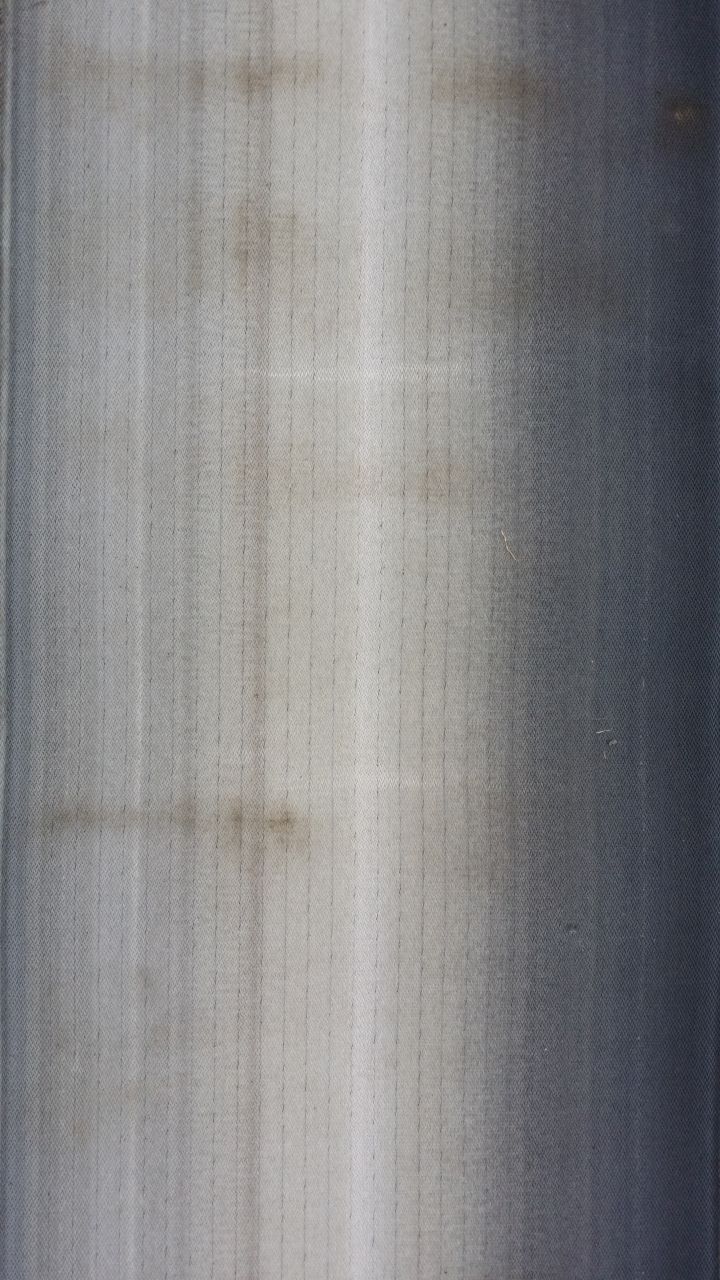
Treadmill Running Belt is slipping on the motor
This section deals with issue relating to the belt not being correctly moved by the motor.
- Why is Your Treadmill Belt Slipping or Skipping? (How to Fix) – Treadmill Reviews 2022 – Best Treadmills Compared - A really good article, why re-invent the wheel.
- The Belt Needs Lubrication
- Drive Belt May Be Loose (needs more tension)
- The Pulley on the Front Roller May Have Lost its Grip
- Walking/Running Belt May Be Too Lose
The Running Belt might need oiling/Lubrication?
- If the belt slips on the motor.
- The treadmill is making a droning noise.
- The speed is inconsistent, i.e. when your feet touch the belt, it slows down.
How to lubricate your Treadmill Running Belt
- How To Lubricate A Treadmill Belt | YouTube - Give your machine a longer life and help it run smoothly with this instructional video on how to lubricate your treadmill belt.
Carl Lewis MOT25 - General
Description
The Carl Lewis MOT25 Foldable Motorised Treadmill comes with a 0-9mph speed range and a full 15% maximum power incline, adding more variation to your workouts. Workout programmes and pulse monitor provides motivating and safe exercise. The running deck folds up at the press of a button and can be wheeled away for easy storage.
Features
Walking and running are some of the best forms of exercise for improved general fitness. Using a treadmill puts less impact on your joints and also offers a more varied workout with performance feedback.
- Power incline 0 - 15%
- 3.0 HP peak
- 0 - 10 mph speed range
- Cut off key
- Power folds for storage
- 41 x 132cm running area
- Computer Displays; speed, distance, time and pulse
- Product dimensions: (H)117, (W)160, (D)80cm
- Max body weight: 115kg
Links
Servicing Carl Lewis MOT25 Treadmill
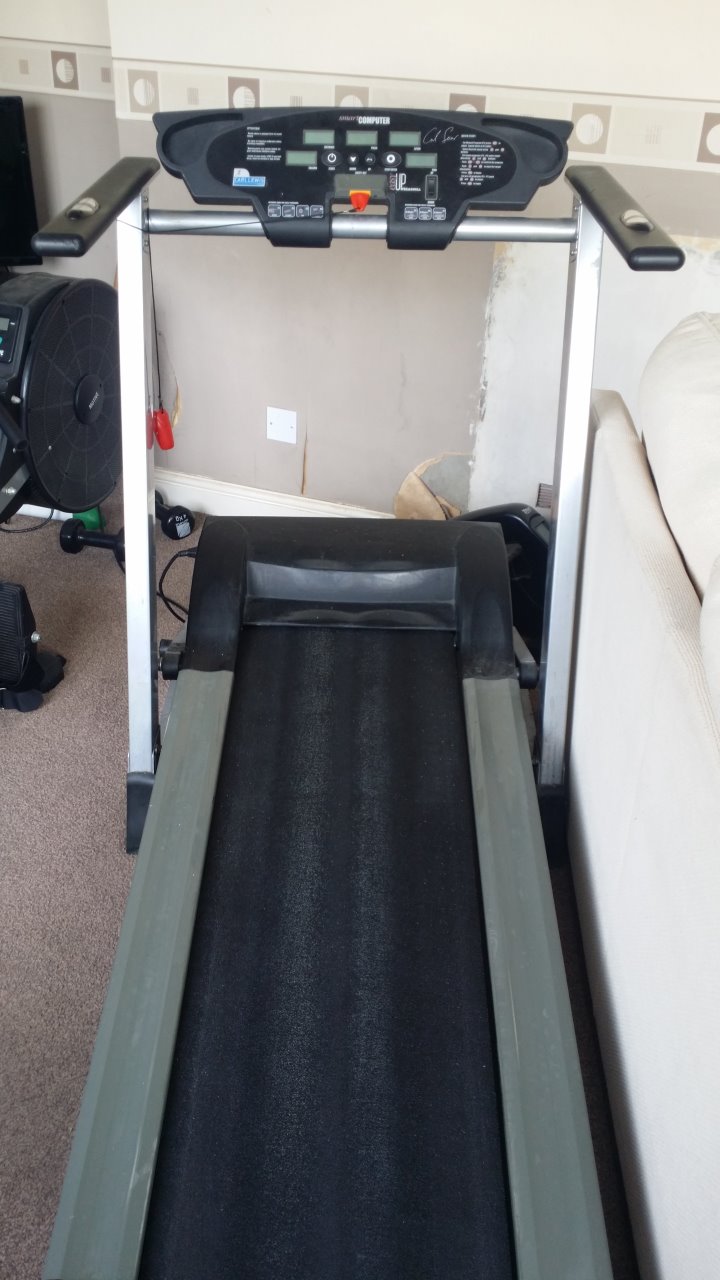
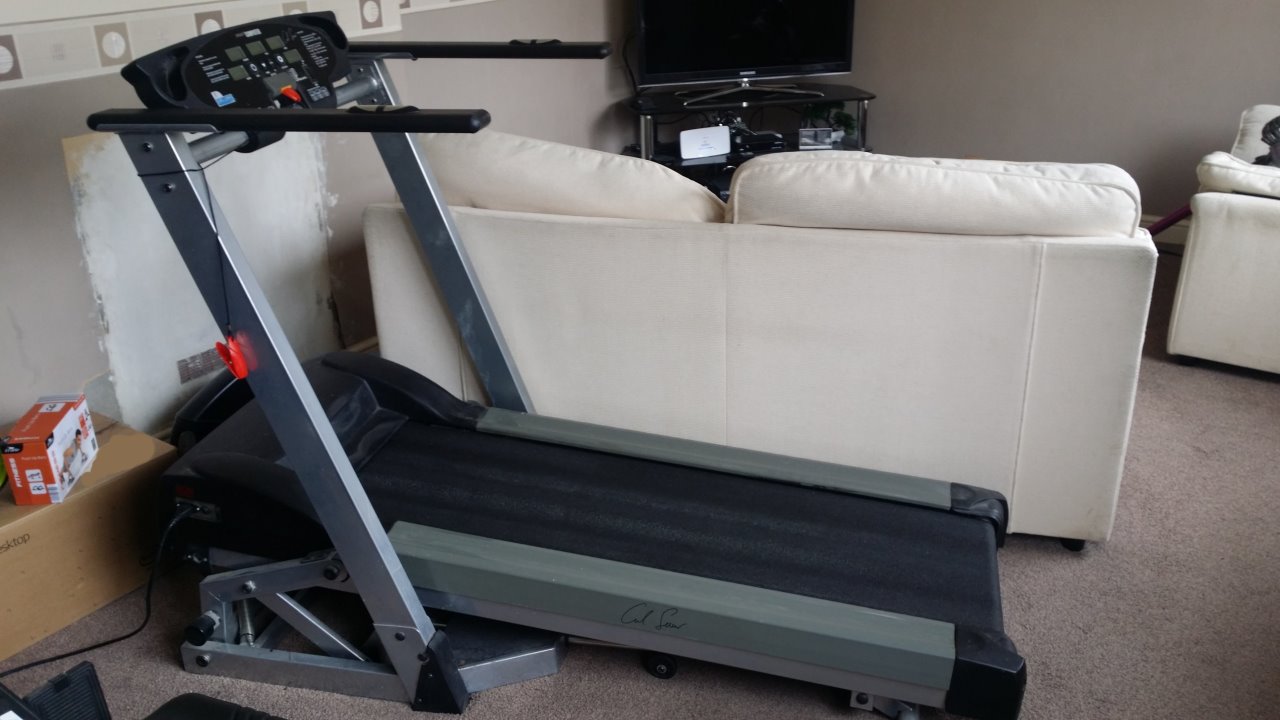
Servicing the Console
On my console I found I had the following issues
- Buttons did not work properly, and would stick often.
- Console was very loose and so would not stay upright
- LCD displays were not always working properly
Follow these instructions and you should be able to fix both.
Obviously make sure the unit is not plugged in
- Sellotape the console to the handles as shown below. This prevents the unit falling while you are taking it apart.


- Unscrew the 15 screws at the BACK of the unit. There are 4 screws under the sticker on the front which would allow access but it would make a mess of your console so i decided not to go this route.

- Carefully pull the back casing away from the unit and you will find some wires fall out. Make a note of these wires and how they look for easier re-installations, a photo with your phone is probably best.
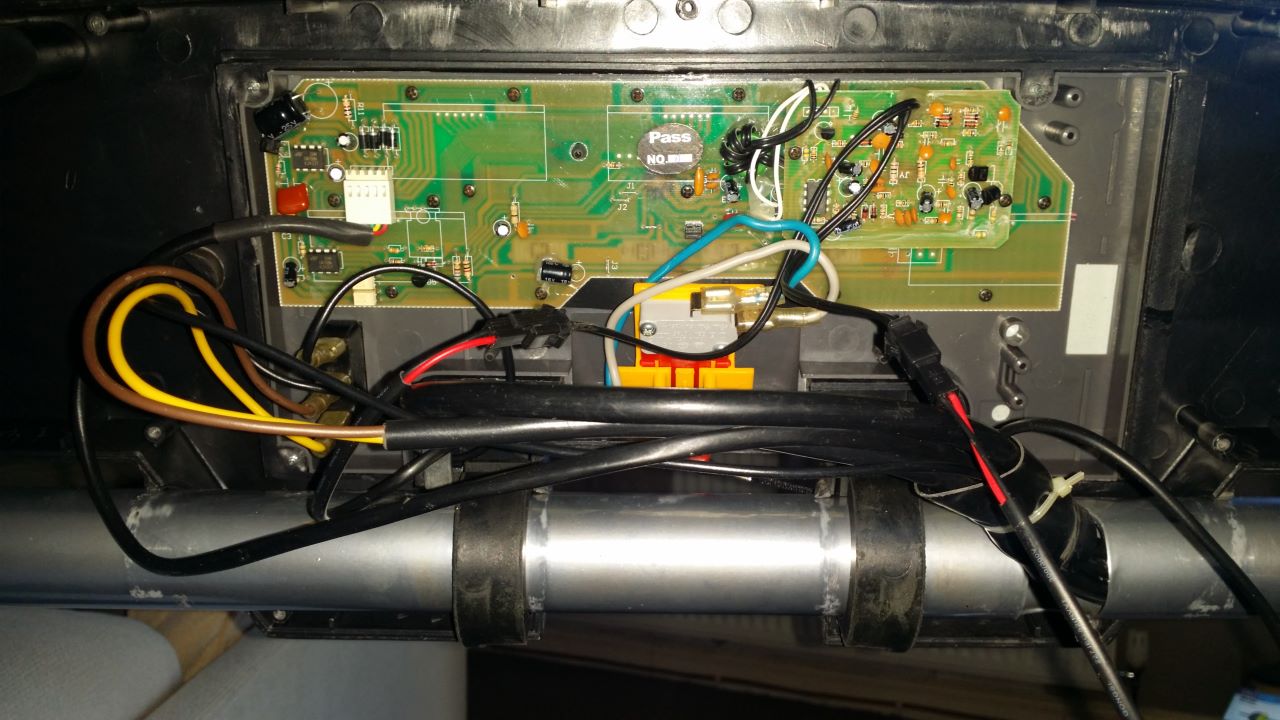
- Put the case back to one side. I would put the screws in this to keep them safe.
- Reposition the case for easier access to the PCB.
- Remove the Sellotape holding the case in place
- Push the case forwards and it will come off the main crossbar
- place the console case flat on the arms of your treadmill
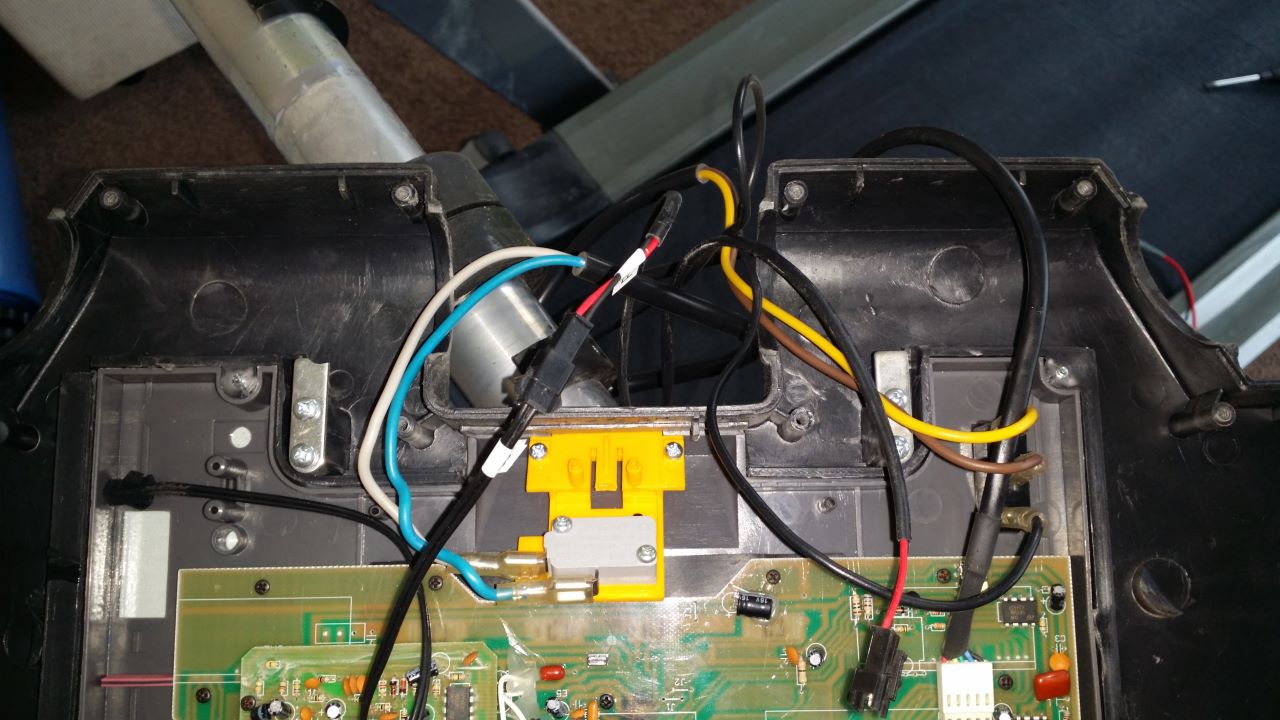
- Remove the 2 rubber grommets making not of their position
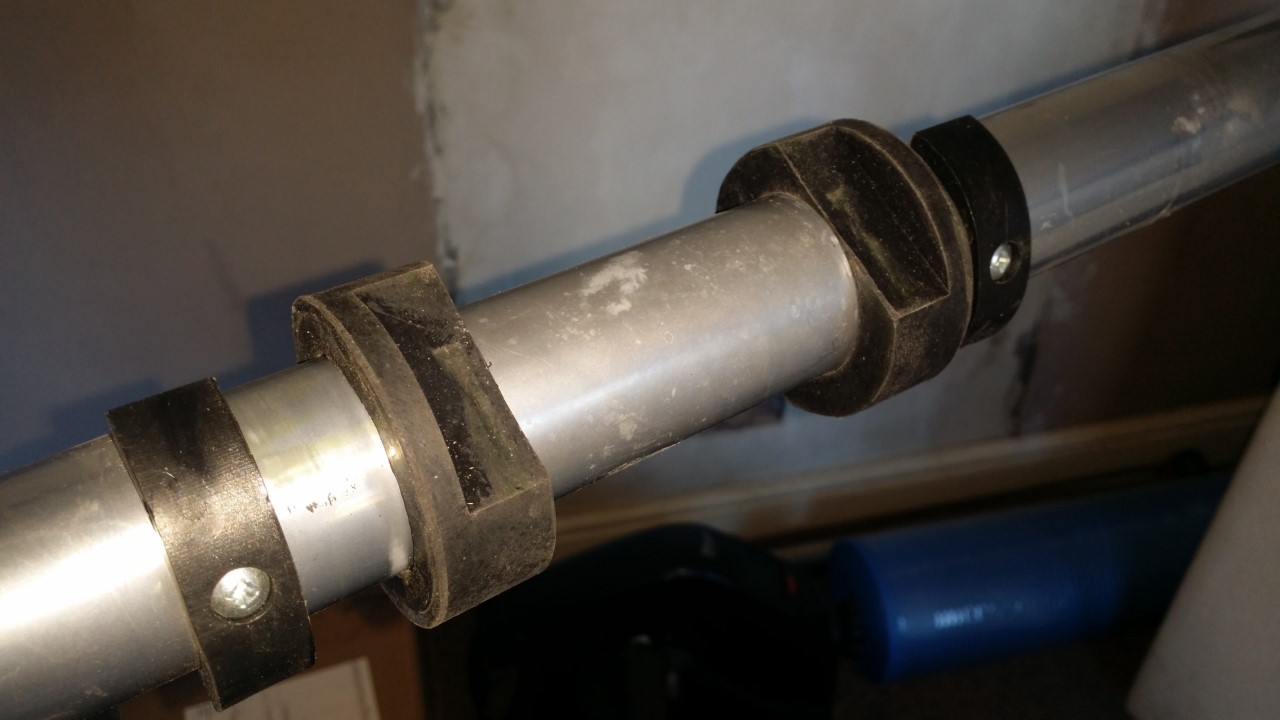
- the flat bit goes at the bottom and allows the screw cylinders to meet each other when you put the case back together
- Clean the rubbers and crossbar (this fixes the console not standing up straight)
- simply was the rubber grommets in warm water (no soap) with your hands to remove all of the dirt and then let them air dry some where warm in your house.
- If the rubber has perished, use a fine grain sandpaper to roughen them up a little.
- Clean the cross bar with a lint free cloth and some Isopropanol Alcohol
- If you want to remove the wires from the PC to make things easier, make notes of what went where or take several photos.
- I personal left all of the mains wires connected and just disconnected the heart monitor sensors after putting labels on them and then motor control plug.
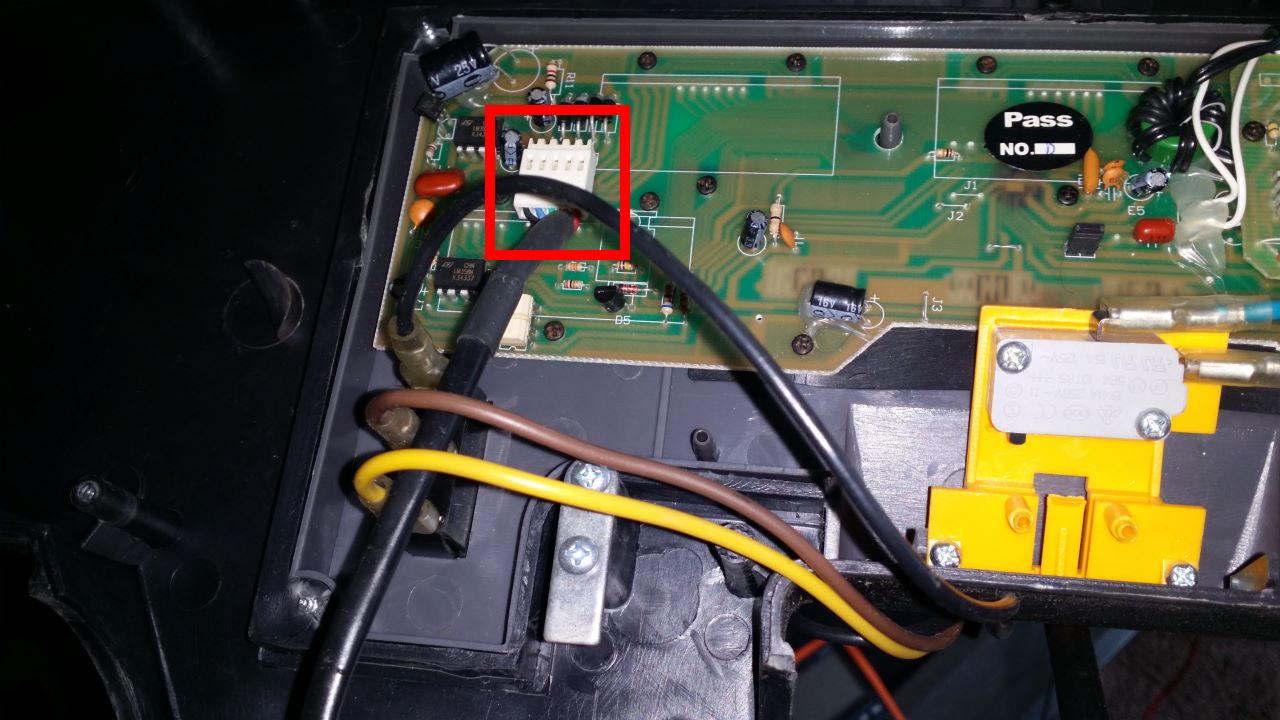
- I personal left all of the mains wires connected and just disconnected the heart monitor sensors after putting labels on them and then motor control plug.
- Remove the 2 screws from the heart rate monitor module.

- Remove the other black screws from the main PCB.

- Note how tight them were.
- Also the image above still has the Heart Rate monitor attached. There are 2 more screws underneath it for the main PCB.
- You can now remove the PCB from the case.
- Some of the LCDs and their rubber connectors will still be attached and some left on the PCB, so make note of what went where
- Pull the rubber buttons out and clean them
- Warm water in your sink (no soap) and wash with your hands gently.
- Shake of the majority of the water and then place the rubber buttons somewhere warm in your house to air dry. You should make sure both sides get dried.
- Do not use any cloths to clean these as the fibres will get stuck on the button and you will have to start again.
- The button pads on the PCB need cleaning.
- Using a lint free cloth and some Isopropanol Alcohol just rub on the pads gently until they are clean
- Cleaning the display feed PCB pads - I have not done this bit.
- Using the same technique as the cleaning the button pads, clean the display PCB pads
- Cleaning the display rubber signal transfer pads - I have not done this as I am not sure if this will damage them
- Clean them with Isopropanol Alcohol
- Re-install the dry and clean buttons
- Re-install the main PCB
- Correctly locate the display transfer pads either on the PCB on on in the main case ready for mating.
- Place the PCB back in the main case
- Screw the PCB down making sure that you lightly press the board down while doing this to get a good compression of pads.
- Re-install the Heart Rate monitor daughter board.
- place down correctly and screw in
- Re-install the dry and clean rubber grommets (in the correct direction)
- Push the case back on
- Correctly locate the wires (as per photo you took earlier)
- push the case back on to the crossbar with the rubber grommets going into their appropriate slots.
- The 2 metal stops should be push against the black blocks on the cross bar. This should put the console in the upright position.
- Sellotape the case in position (as before) so we can work on it easier.
- Reconnect the heart rate monitor
Now is a good time to check if all of the buttons, displays and functions work before continuing. Be safe when messing with mains voltage. Fix any issues before going any further.
- Change to/from Miles/Kilometres if required.
- see notes below
- Push the rear case back onto the main case
- When you do this make sure no wires are trapped where they should not be as this will stop the case going back together.
- If in doubt consult your photo from earlier on how the wires should go back in.
- Done
Your buttons and displays should now work with no issues for years to come.
Changing from Miles to Kilometres
Assuming you have the console opened as described above, the change from Miles to Kilometers or the other way around is easy.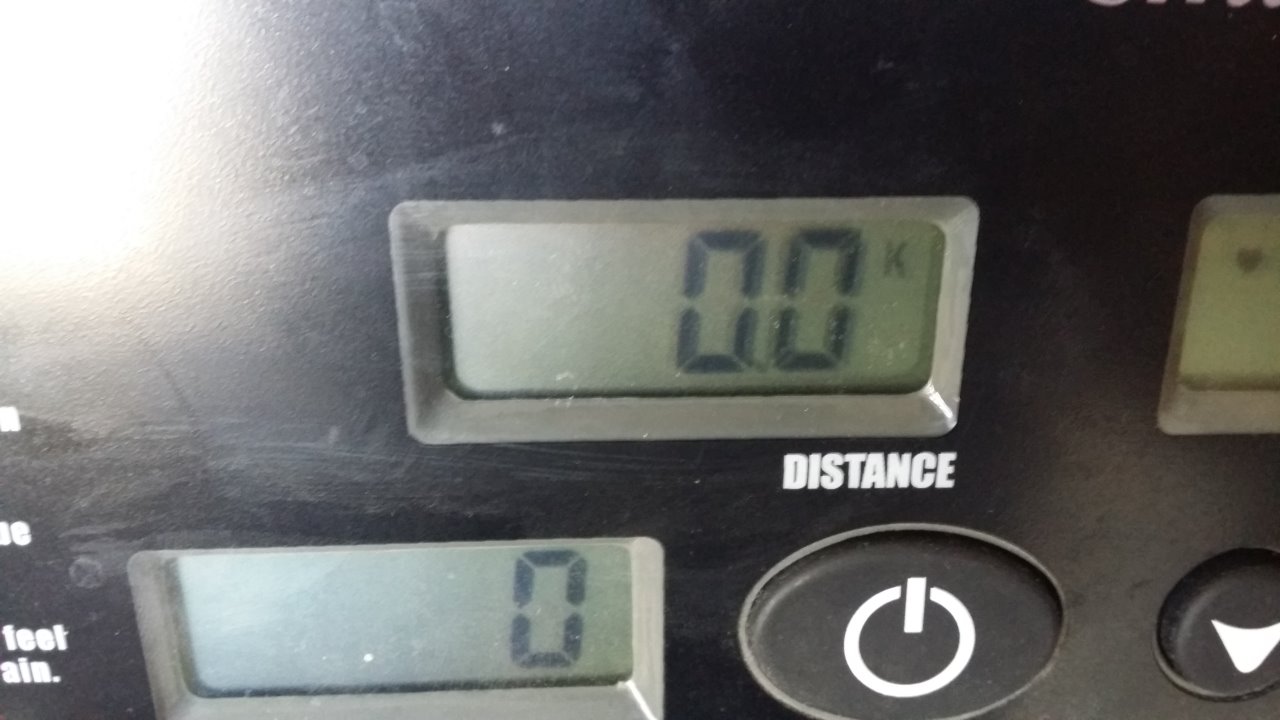
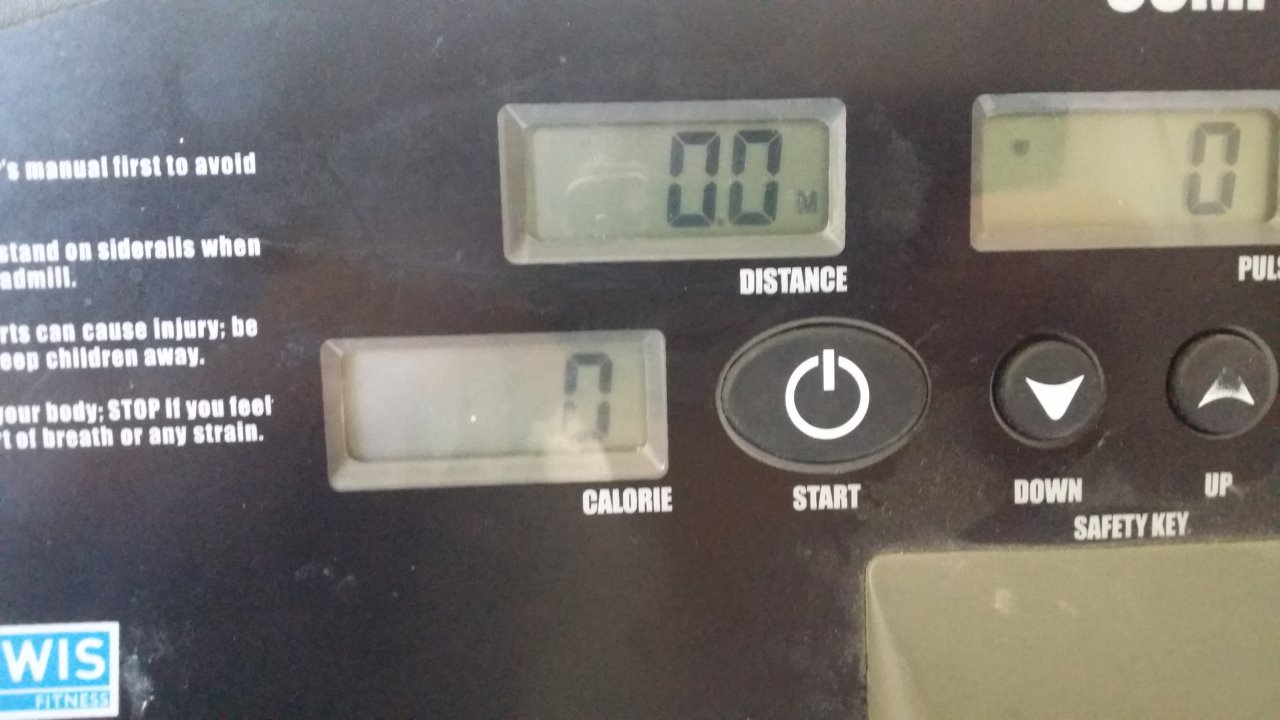
There is a jumper on the PCB that controls this feature and only has 2 positions:
- Closed (Jumper present) = Miles
- Open (Jumper missing) = Kilometres
The location is shown in the image below (currently closed), set to your preference as required:

This option is set in the factory due to the region it was going to get sold in.
Removing the Running Belt
- Put the treadmill flat with no incline
- Because there is a large capacitor in the motor housing you should leave the unit to discharge over night or be very careful.
- Make sure the treadmill is off and unplugged
- Remove the Rear Roller Adjustment covers by removing the 2 screws that hold each of them in.

- Remove the side rails by pulling sliding them off the end.

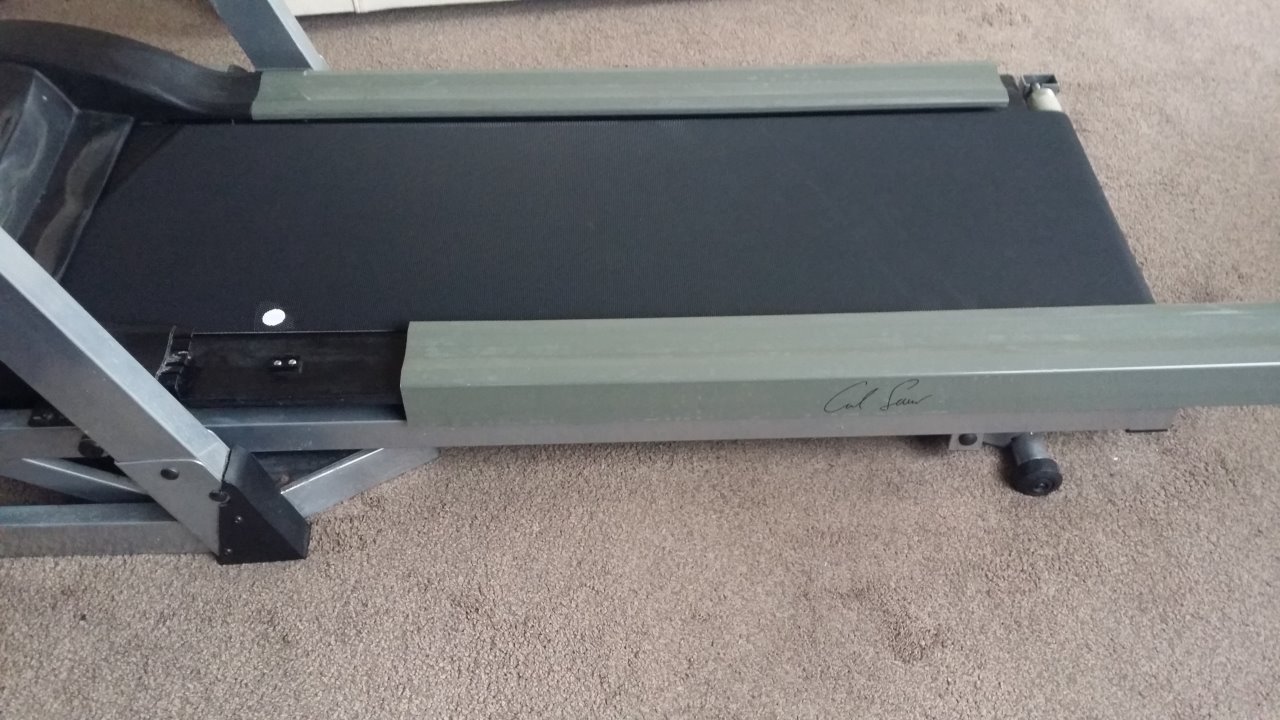
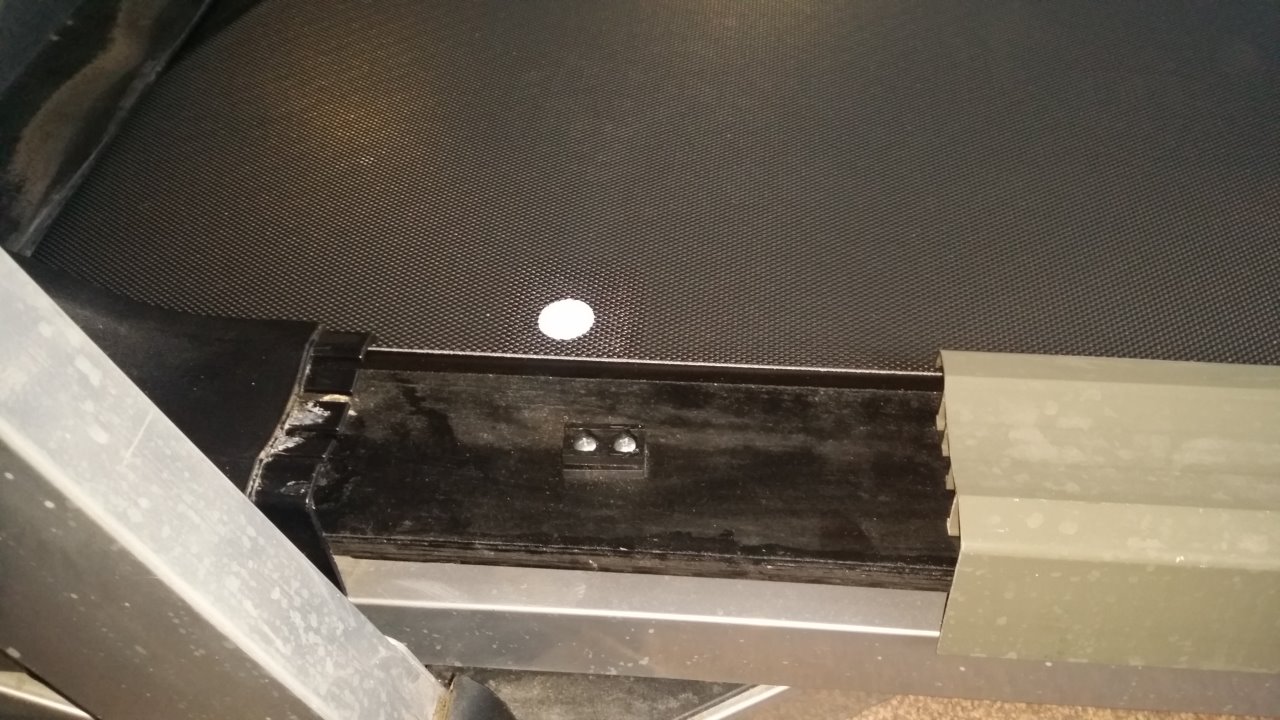
- Your treadmill should now look like this with the Main Motor Cowling still present at the back
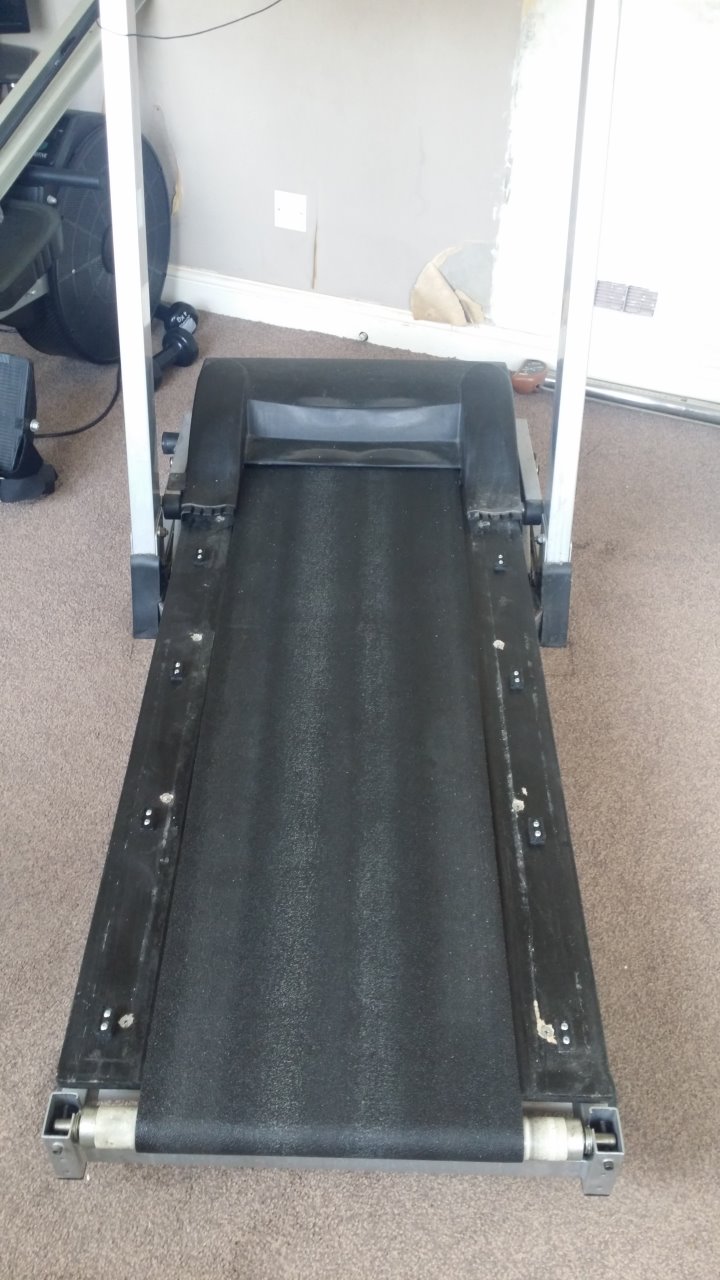
- Remove the Power Supply and Main Motor area cowling.
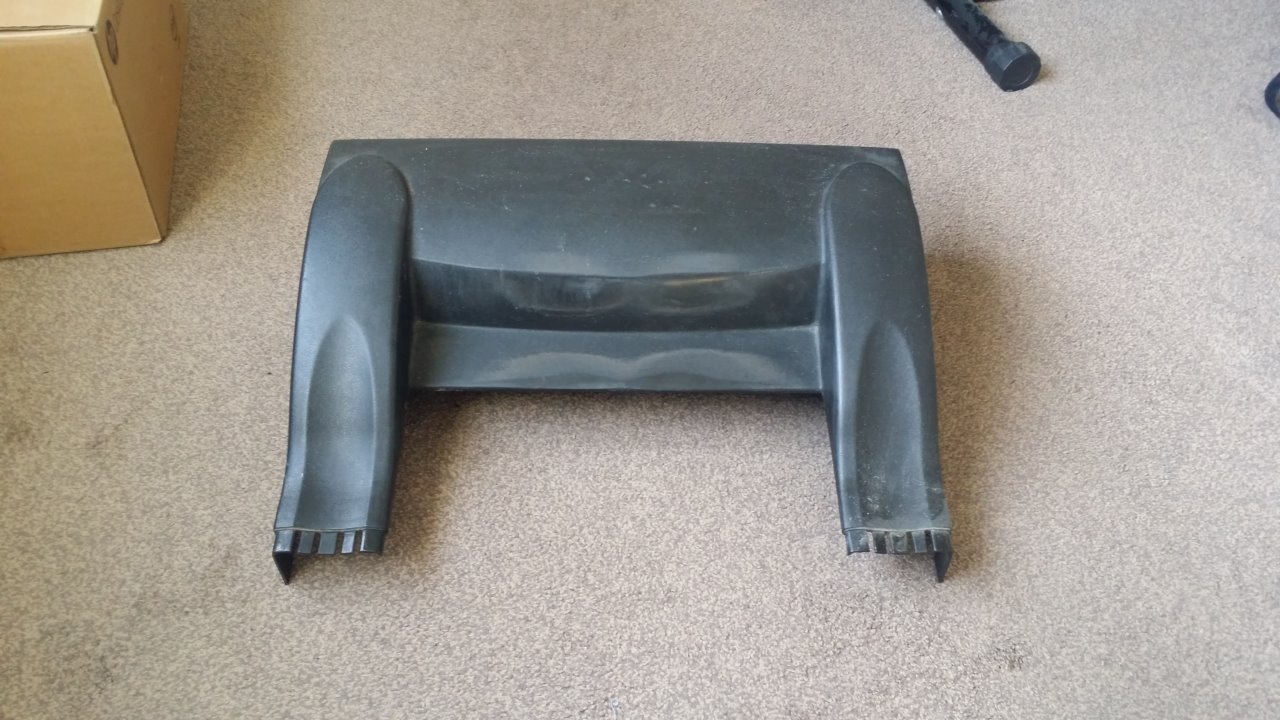
- removing the 4 holding screws
- lift the covering straight up. It should move with relative ease.
- The will now expose the power supply and main motor
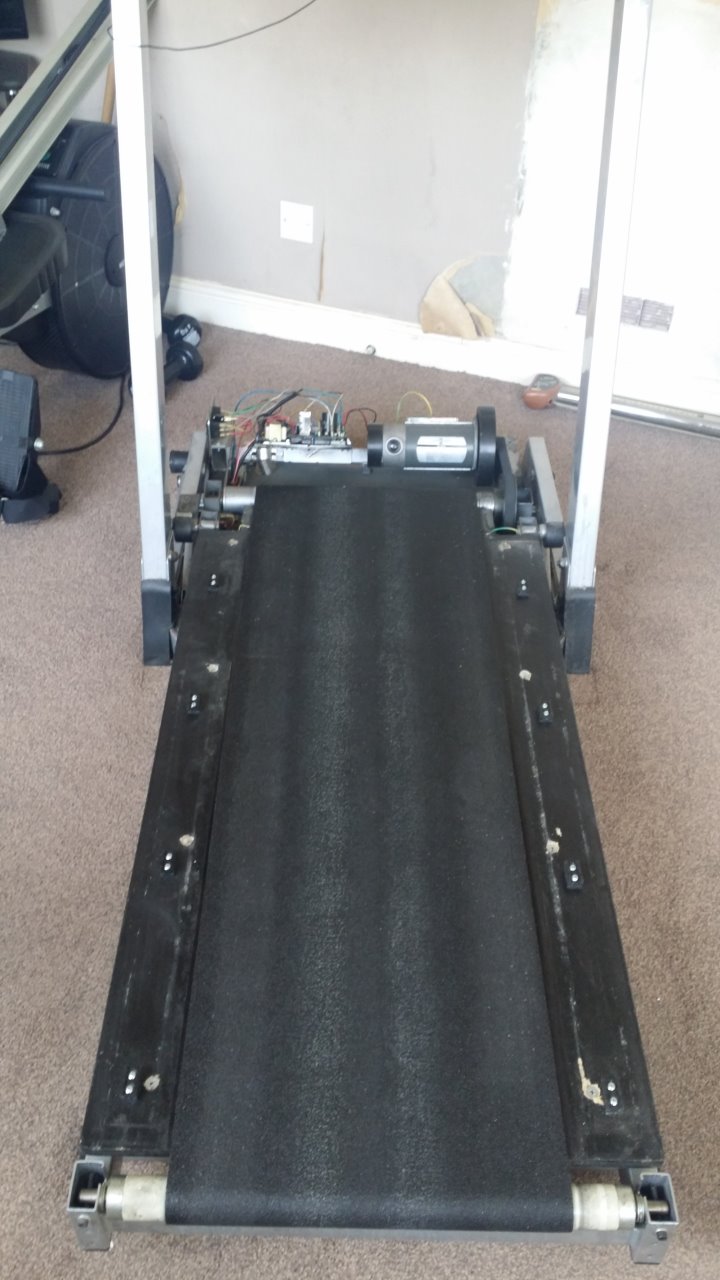
- Remove the Rear Roller (not the motor end)
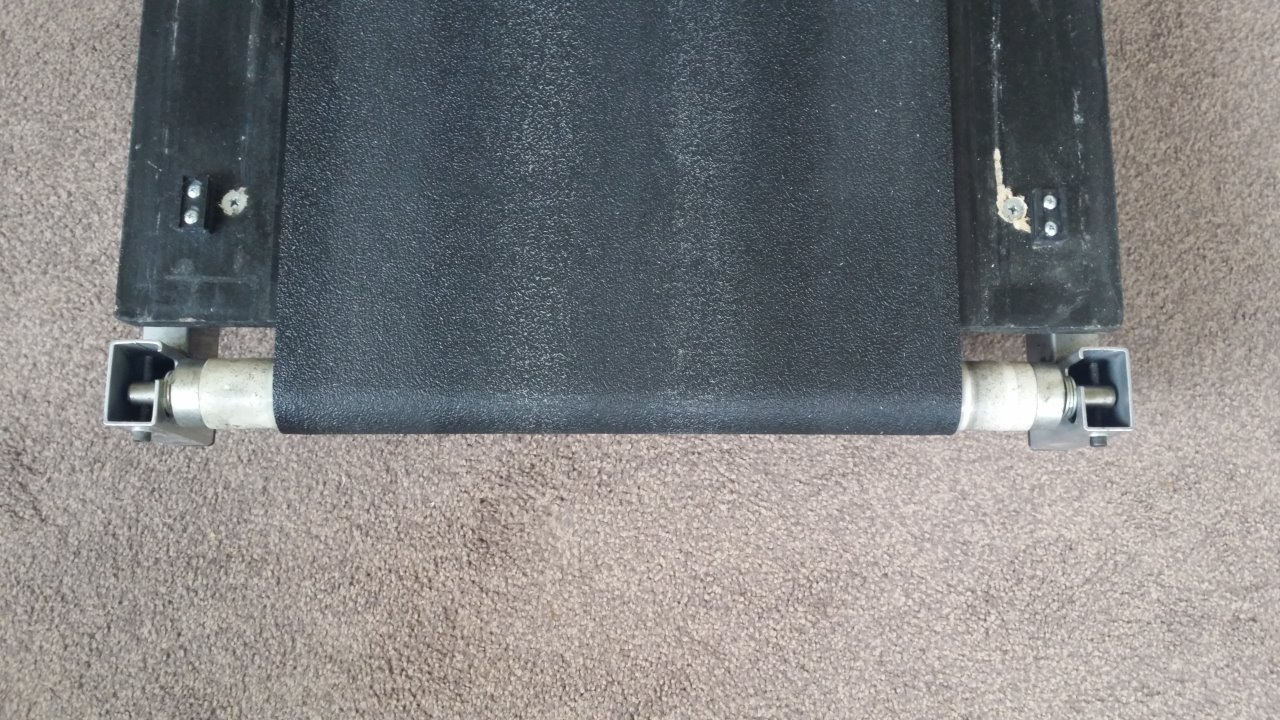
- Unscrew the adjustment bolts a little bit on one side and then the other, so the bolts are released evenly otherwise the roller could become stuck or damaged. Keep doing this until the bolts have been removed.
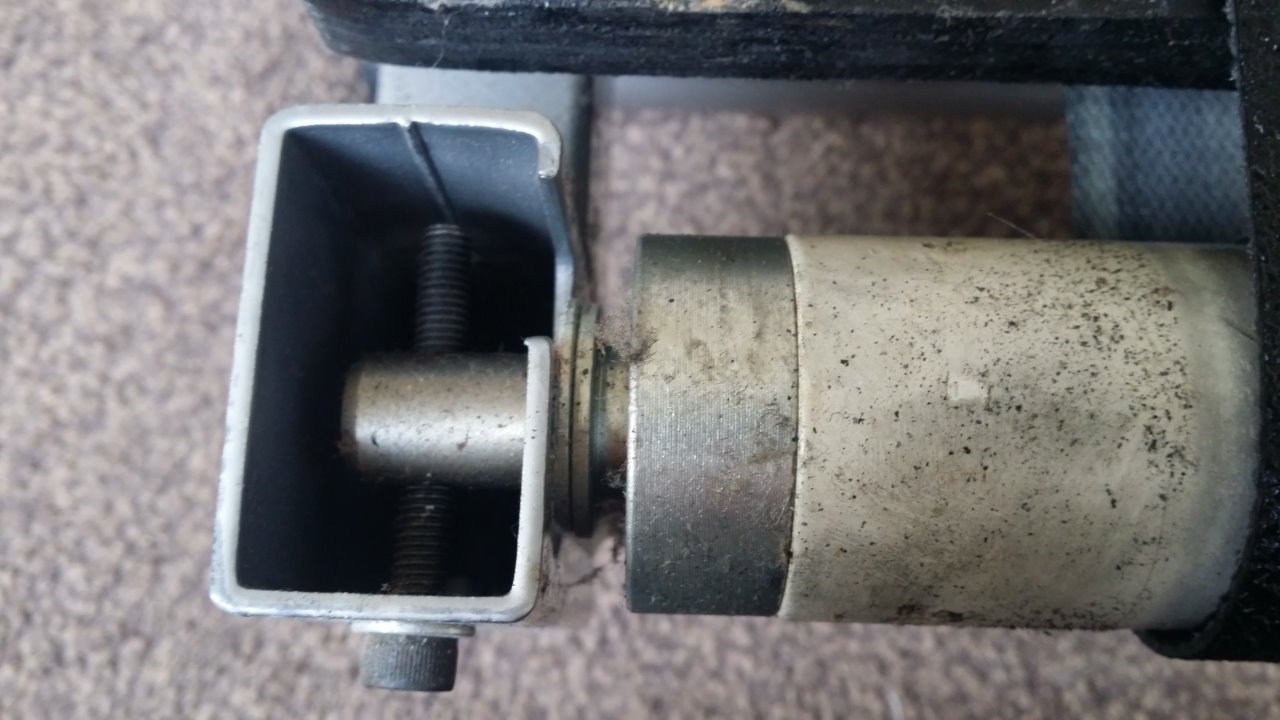
- Put the bolts to one side
- Take a photo of the roller so you know how it was installed
- The roller is now loose and can be removed by pushing it towards the motor
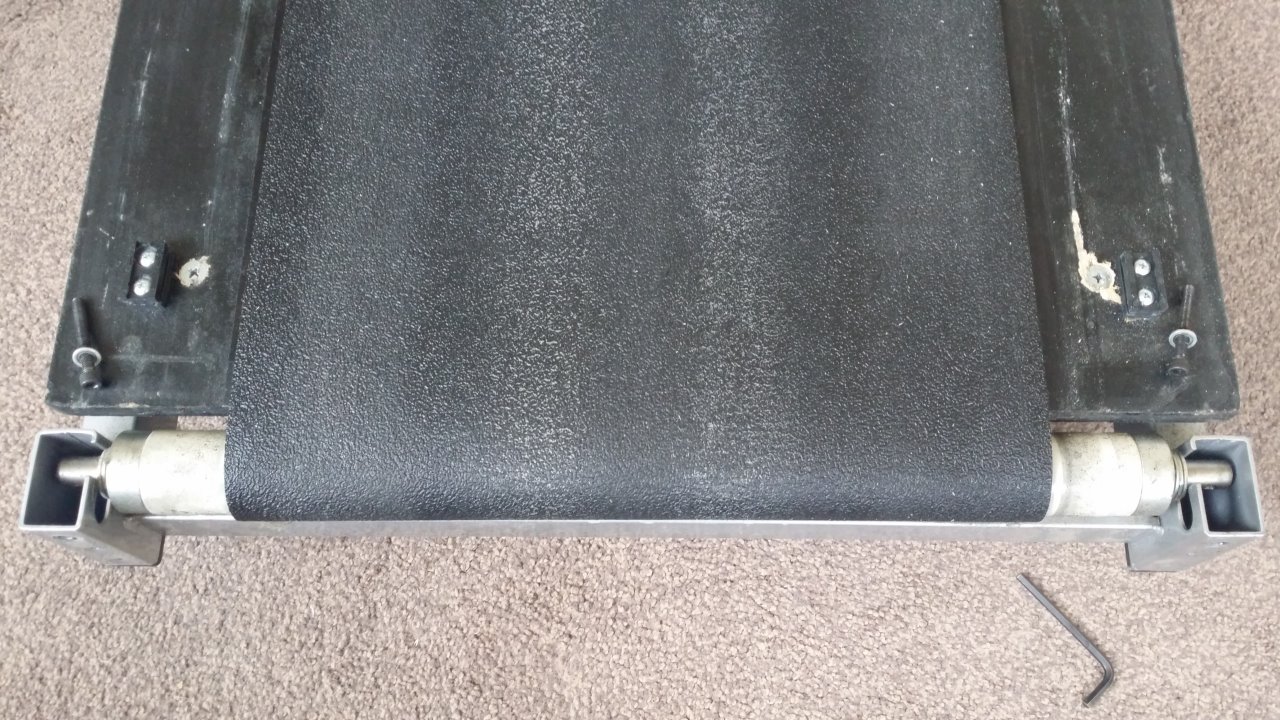
Make sure you do not loose the metal washers
- Place the roller on a piece of clean plastic or surface. A bin/Trash bag should do.

- Put one of the adjustment bolts back in the roller and the other placed back in the treadmill. This is so you can identify which way around the roller fit in the treadmill.
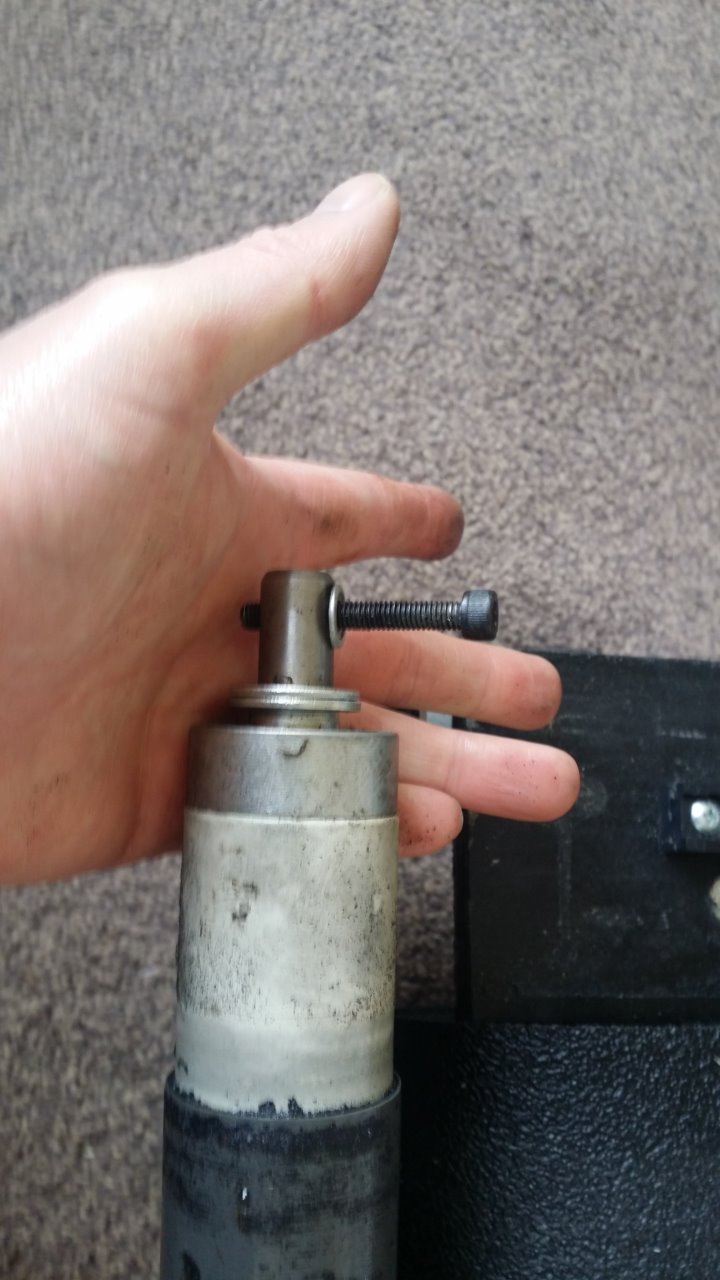
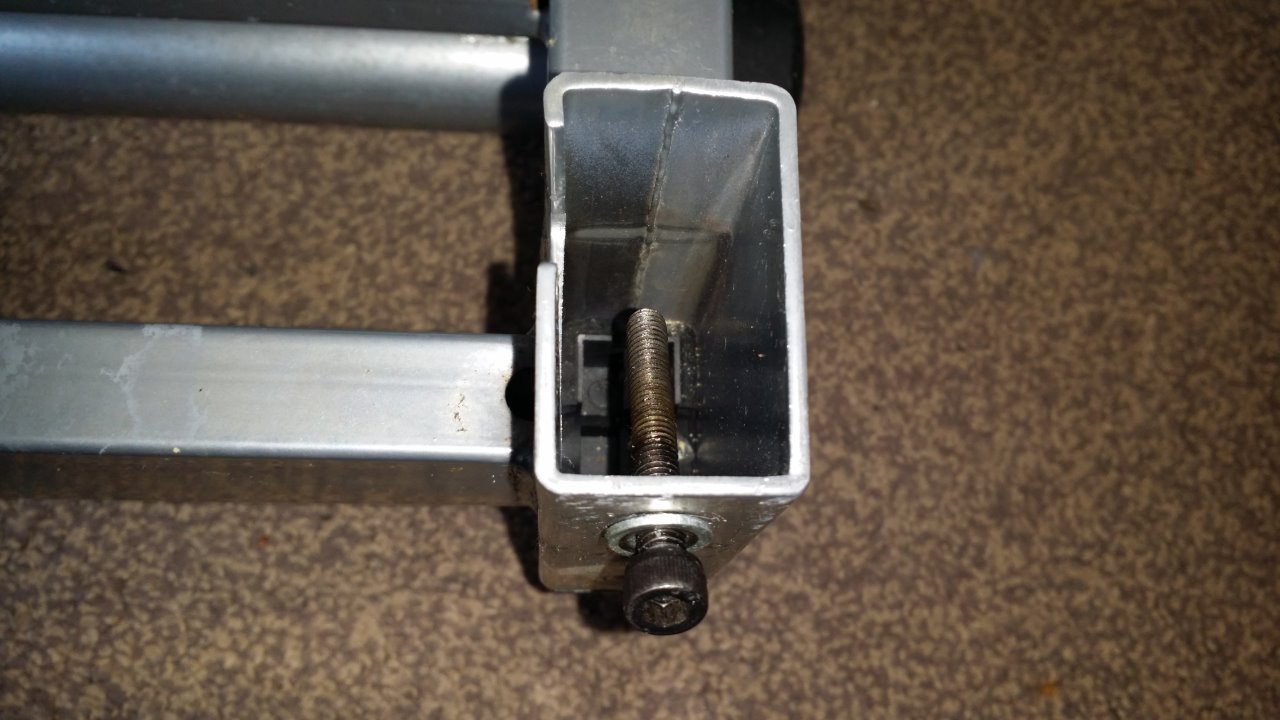
- Unscrew the adjustment bolts a little bit on one side and then the other, so the bolts are released evenly otherwise the roller could become stuck or damaged. Keep doing this until the bolts have been removed.
- Remove the front motor roller
- Before removing the bolt, put some Tipex on the shaft so when you take it out you know the insertion depth it was set at.
- The adjustment bolt should be unscrewed all the way.

- Remove the motor belt whilst making a note of what direction it goes in
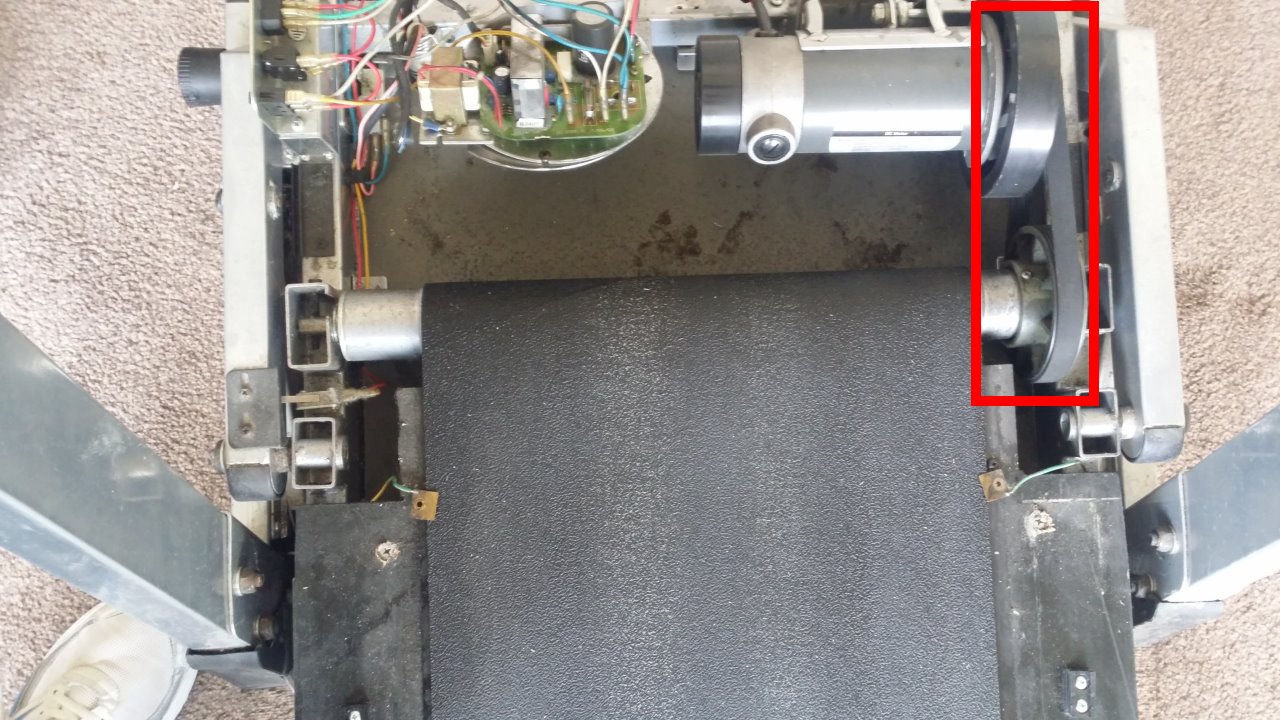
- Remove the roller and place next to your other roller.
- Remove the the Deck (and belt)
- Unscrew the anti-static plates from the Deck and then put the screws back in the board for safe keeping

- Unscrew the Deck fixing screws in the order as shown below but only partway before you move to the next screw.

- They have to be removed in this way because the screws sometime unscrew the rubber mounting below instead of coming out on their own and this method prevents the Deck from getting damaged by lifting the Deck evenly irrespective of which screws fail to come out of their rubber mounting on their own.
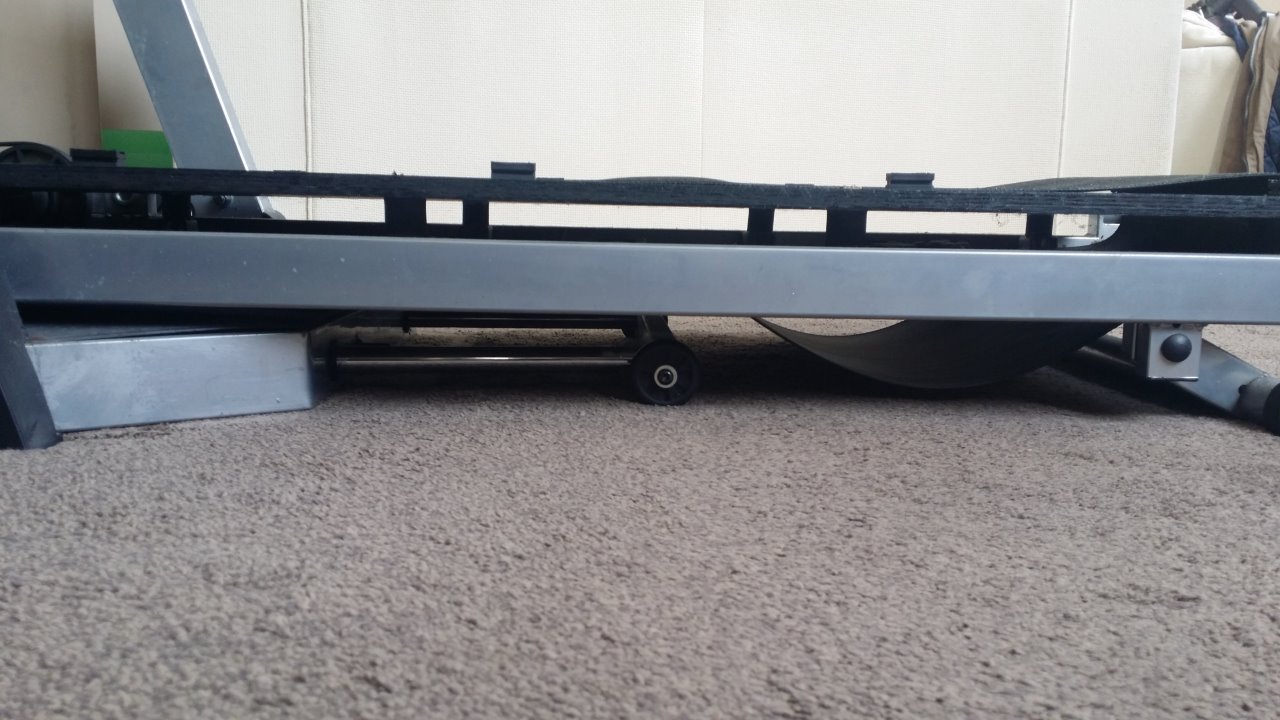
- Take your time doing this section and make sure you use a the correct screw fitting (low profile fat cross)
- When you think you have undone the all of the a screws, lift the Deck and see if it is free.
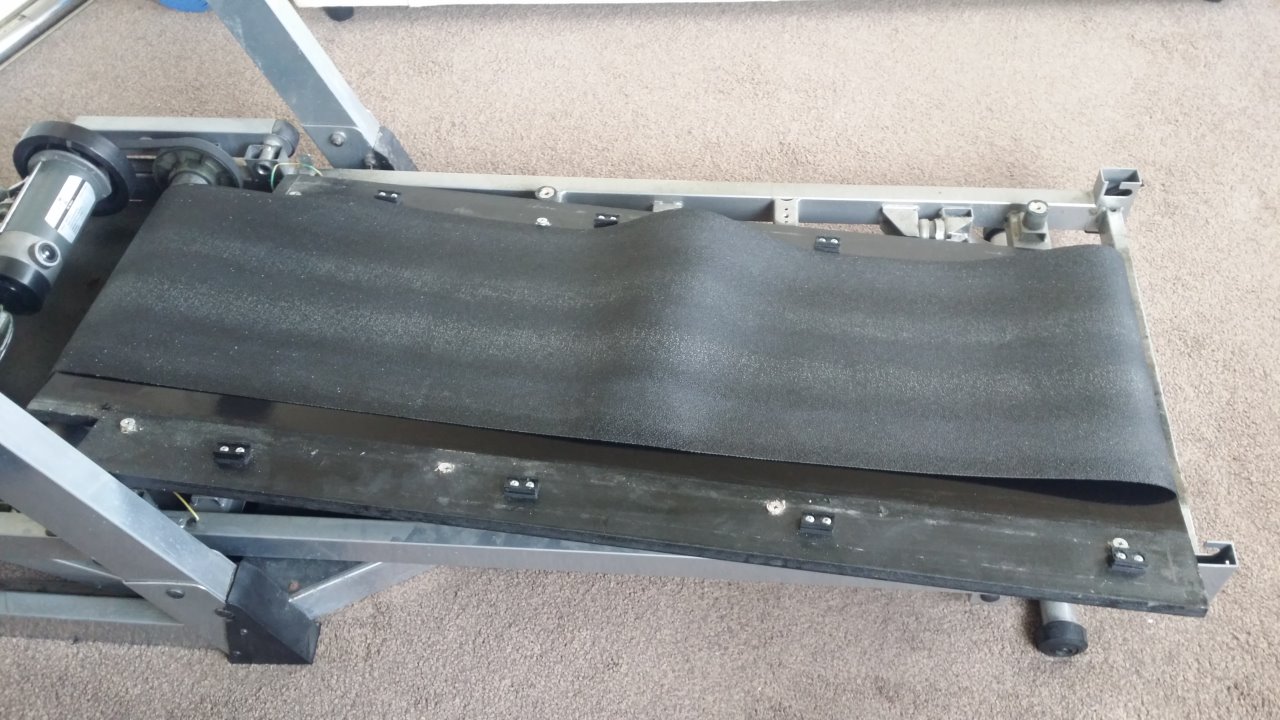
- When free lift both the Deck and the belt away from the treadmill.
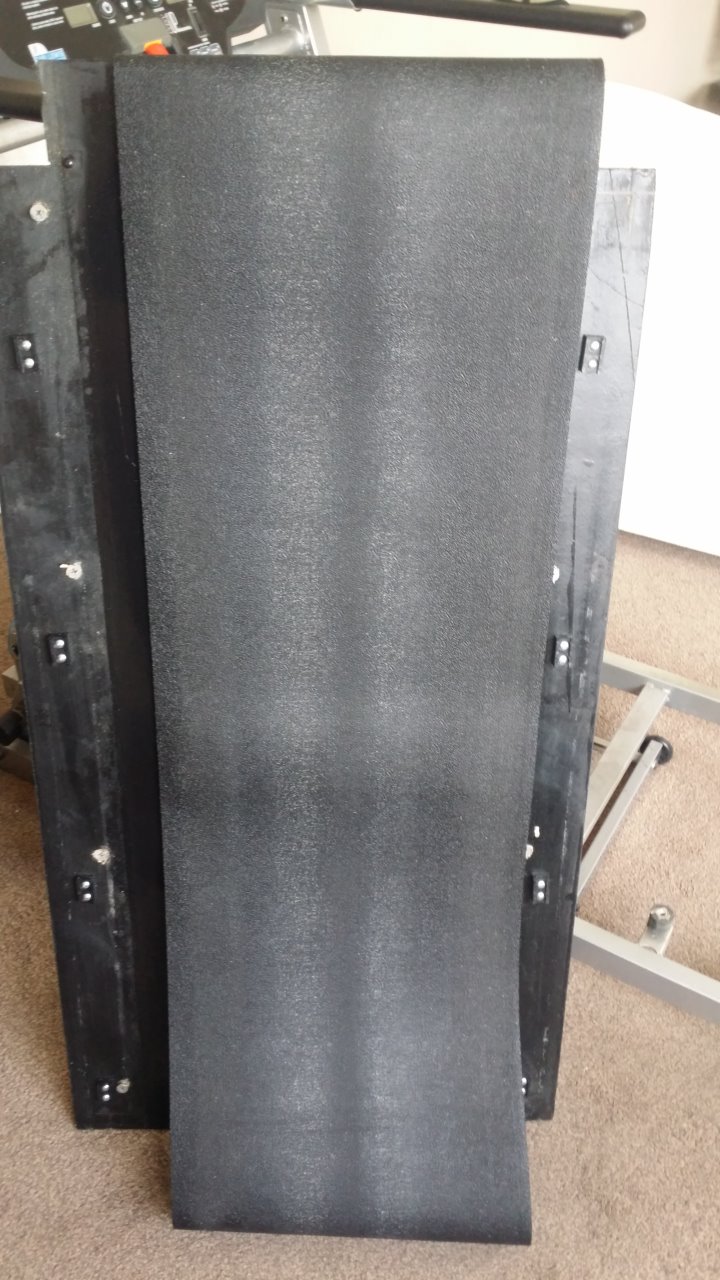
- They have to be removed in this way because the screws sometime unscrew the rubber mounting below instead of coming out on their own and this method prevents the Deck from getting damaged by lifting the Deck evenly irrespective of which screws fail to come out of their rubber mounting on their own.
- Separate the belt from the Deck
- The running belt is removed.
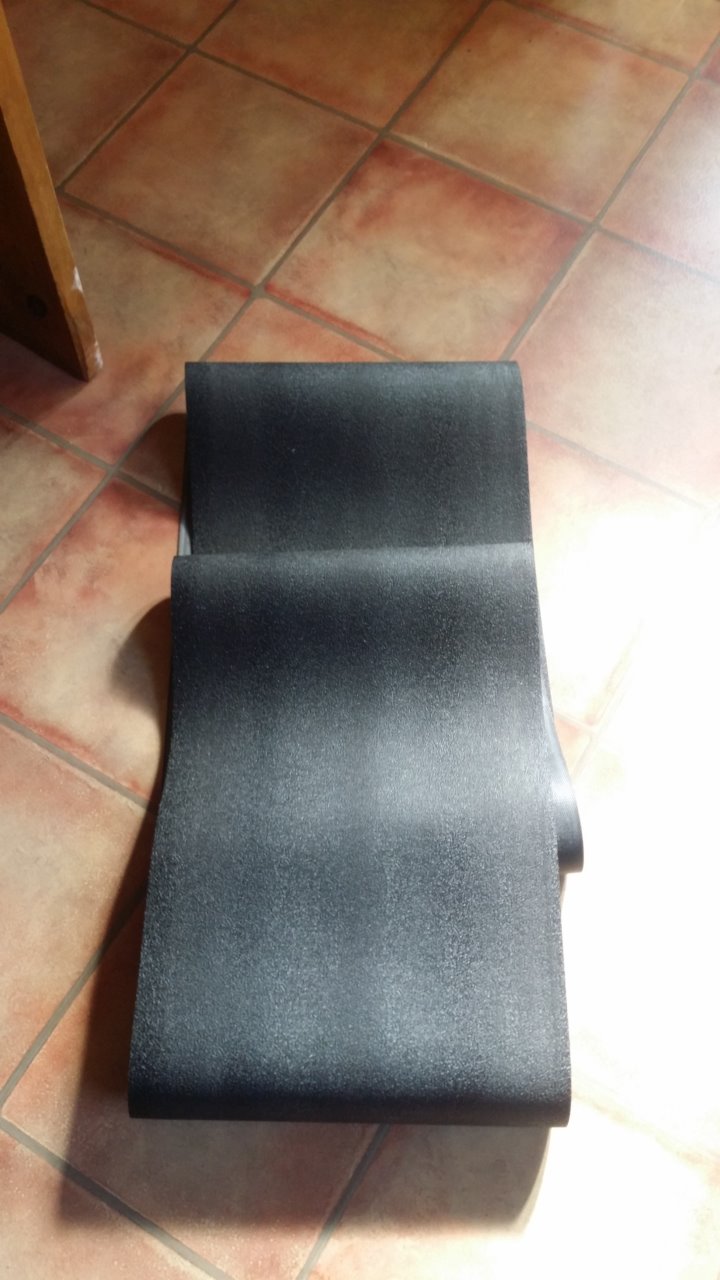
- Remove any rubber mountings still present on the underside of the deck.
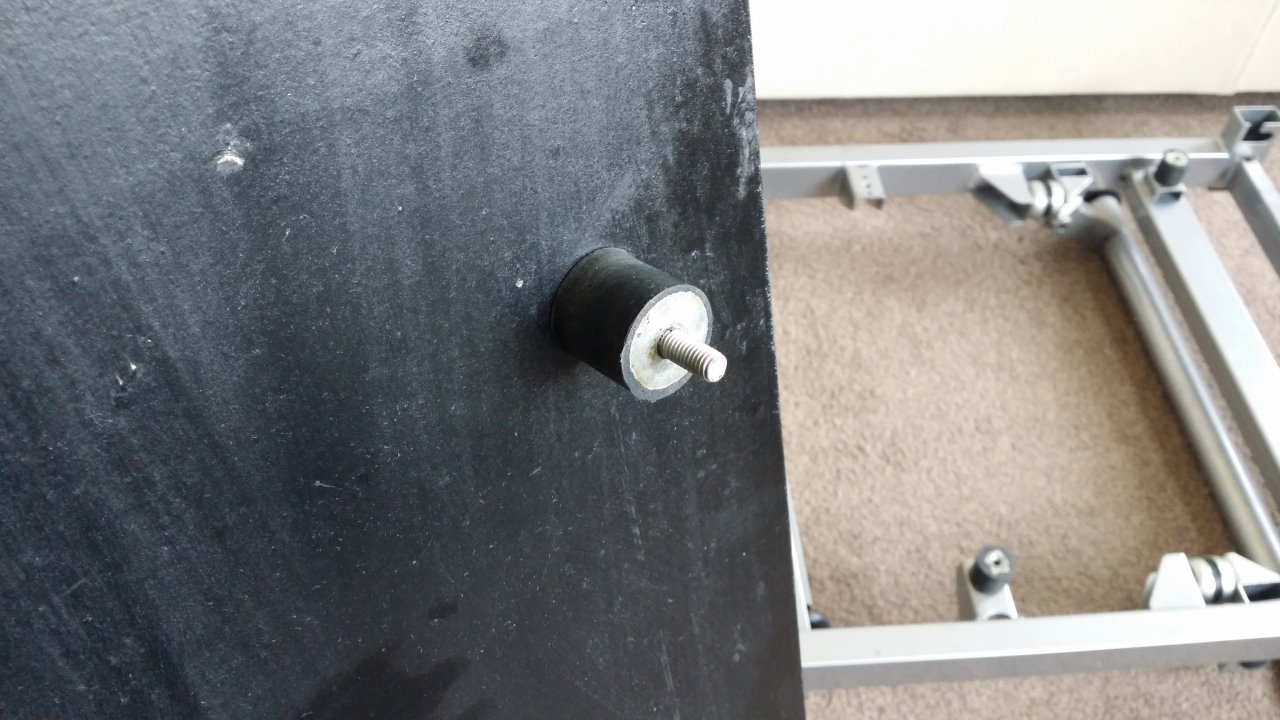
- Your treadmill should now look like this
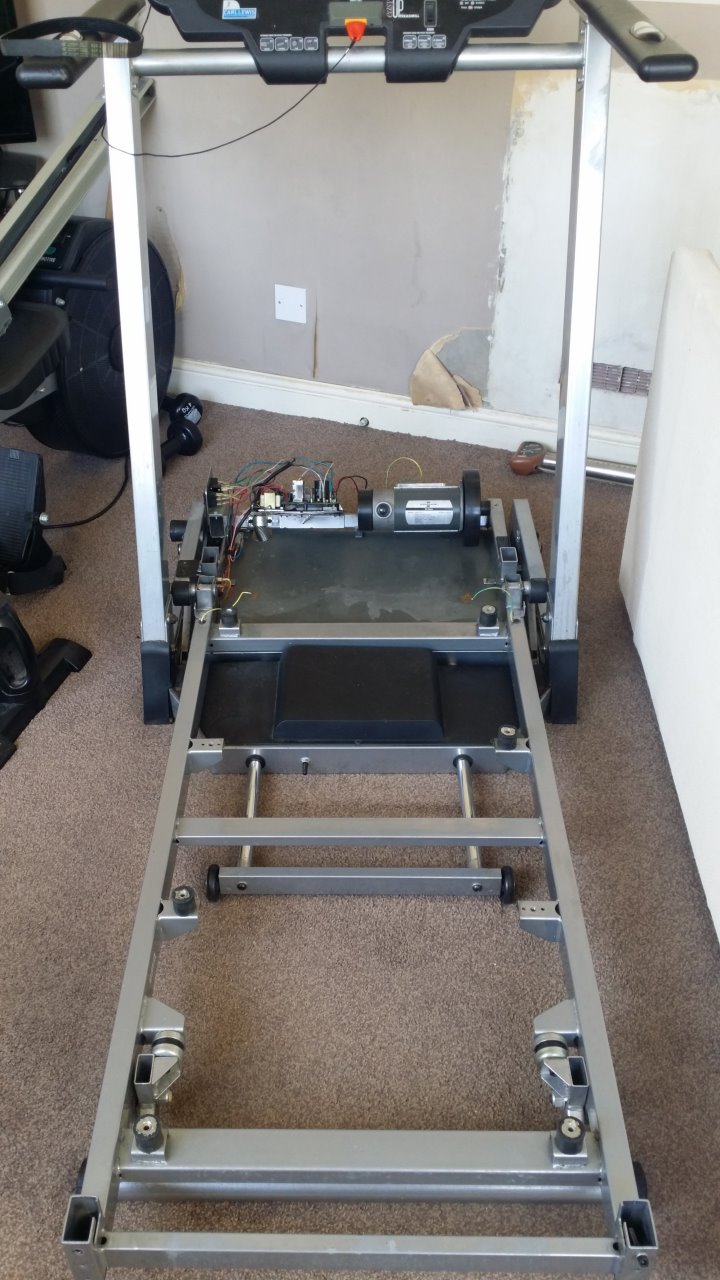
- Replace any rubber mounts that came off with the Deck back onto the frame of the Treadmill.
- Unscrew the anti-static plates from the Deck and then put the screws back in the board for safe keeping
Cleaning the Running Belt area
This assumes you have just removed the old one and your treadmill following the instructions above.
This is optional but highly recommend because you don't swap your running Belt everyday.
While your treadmill is open, clean the following parts with warm soapy water:
- The rollers
- Clean only with a lint free cloth by wiping the rollers clean of any dirt.
- They do not need to be oiled
- So dirt might just need some encouragement with your finger nails to come off, again be gentle.
- Deck
- avoid the slippery running surface with soapy water, this should be cleaned with a clean lint free cloth only
- Anti-Static plates
- The side rails
- The corner covers
- The Motor Housing/Cowling
- The Motor area
Installing a new Running Belt
This assumes you have just removed the old one and your treadmill following the instructions above.
- Follow the instructions above in reverse with the following exceptions:
- Before running or configuring the belt, Check to see if your Running Belt needs Lubrcation. If it does, apply some lubrication sparingly to the slide surface of the Deck. This is important to prevent damage.
- Done
Front Roller Angle Configuration
Not all Treadmills have this adjustable front roller
This is required otherwise your Running Belt will always track left and no amount of adjustment will fix it.
Method 1
- Screw the thread in to the Tipex mark you made earlier on the adjustment bolt
Method 2
- Pull the belt tight against the Front roller
- With your hands evenly placed on the belt (so both sides are pulled the same)
- Palm down and pulling the running belt towards you
- Not much force is required
- The motor will make a bit of a weird noise, but this is normal
- You should now see that the running belt is probably on an angle
- Using the drive roller adjustment bolt
- Tighten this slowly until the Front Roller and therefore the Running Belt are in alignment (parallel) with the Deck. Check with a ruler as shown below.

- The belt should be in the middle of the slide surface.
- Every few turns you might need to re-pull the belt with you hands to make sure it is sitting right and the adjustment is applied correctly.
- Tighten this slowly until the Front Roller and therefore the Running Belt are in alignment (parallel) with the Deck. Check with a ruler as shown below.
How to configure the Running Belt's tension (Euro Treadmill Belts Method)
Video: Replacement treadmill belt - how to tension your belt | EuroTreadmillBelts.com
These are my notes for this method which I have used successfully.
You can use masking or electrical tape instead of Tipex
- This method creates a 0.5% pre-tension on the belt.
- This is a precise method and so should your measurements
- Before starting, the belt should be installed but not tensioned
- Tensioning your belt
- Make 2 marks on each side, exactly 1 meter apart. It does not really matter where these marks are as long as they are 1m apart.
- Leaving the tape measure on the treadmill (not on the Running Belt), tension one side untill you have stretched it my 5mm. You will see the Running Belt stretch against the tape measure.
- Now do the other side.
- See if the belt is now gripping, if not, tension each side up a little more (not too much)
- Dynamically Track
- If the belt is gripping, you can make adjustments using the tension screws independently to correct any issue with the left/right tracking.
- After Fitting
- Ideally the belt should allow enough room to fit the belt and give about 50-60% of the adjustment potential to tension the bel. This allows for further tensioning during the belts lifetime.
Stomp Test
After you believe you have configure/tensioned your Running belt correctly as per the method above, we now need to do a final test.
- How To Adjust A Treadmill Belt | Treadmill Maintenance
- This is best to be done with the cowling of so you can see the actually motor, but is not required.
- Video time is set to the part where the stomp test is demonstrated
- This video also shows you how to track a Treadmill but not pre-tension it.
Re-assemble the Treadmill
This is pretty much the reverse as above (after installing your new belt), but here is an overview:
- Replace the motor cowling
- Put the side rails back on
- Put the Rear Roller Adjustment covers back on.
Cleaning the Incline and Vertical Store motor areas
This area is only possible to access if you put the treadmill into it's vertical storage mode.
- Put the treadmill in to it's vertical storage mode
- Because there is a large capacitor in the motor housing you should leave the unit to discharge over night or be very careful.
- Make sure the treadmill is off and unplugged
- Remove the feet protectors
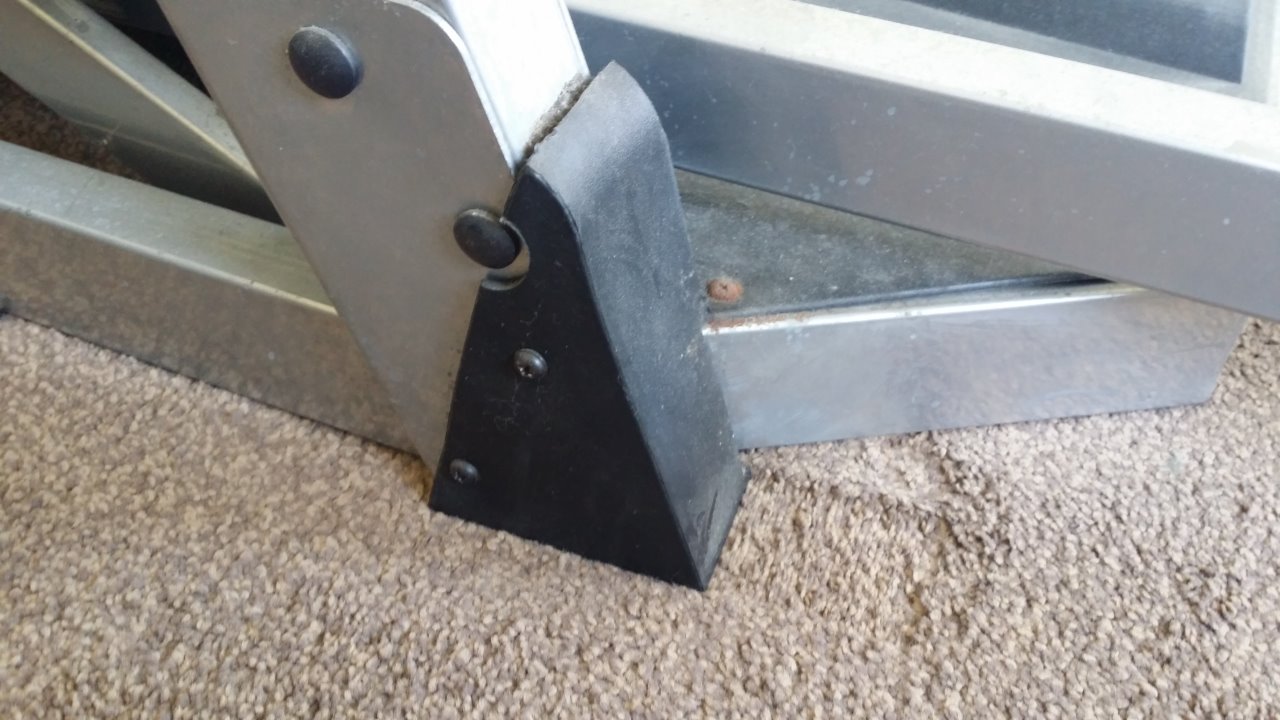
- Remove the Vertical Storage and Incline Motor Cowling
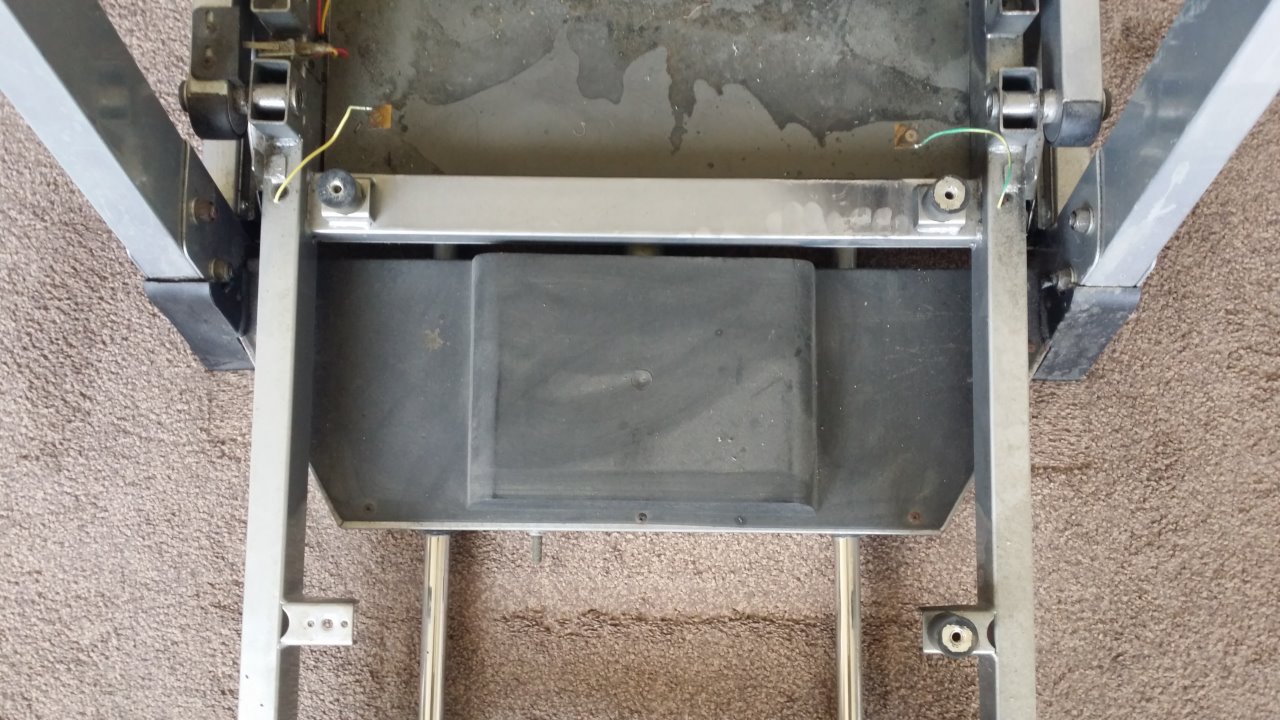
Parts Close Up Pictures
- Power Supply and Main Motor Area (Front)
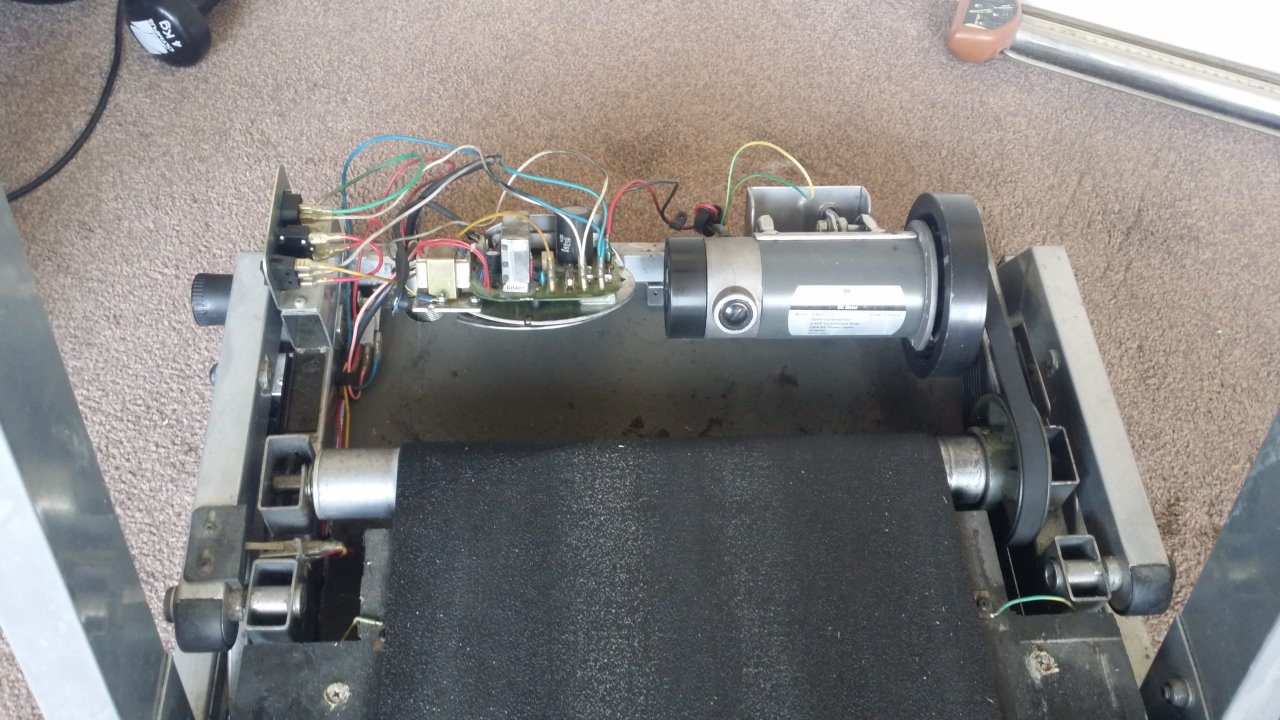
- Power Supply and Main Motor Area (Rear)
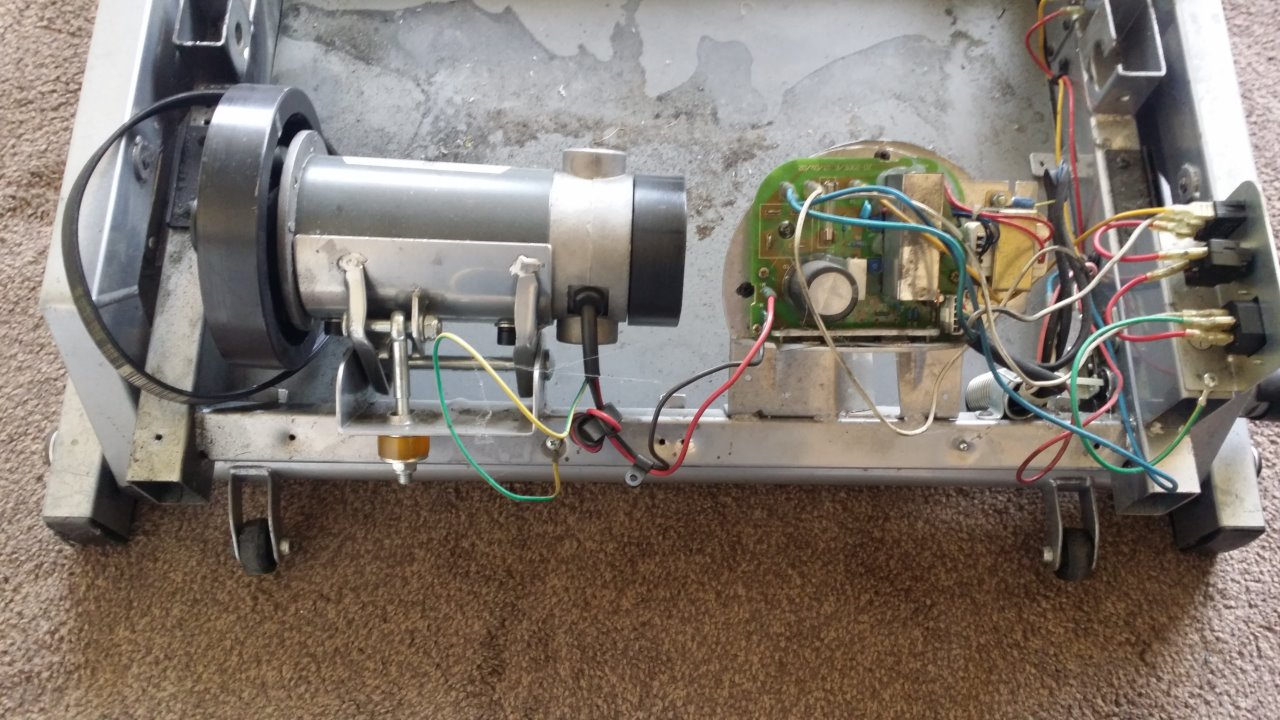
- Main Motor
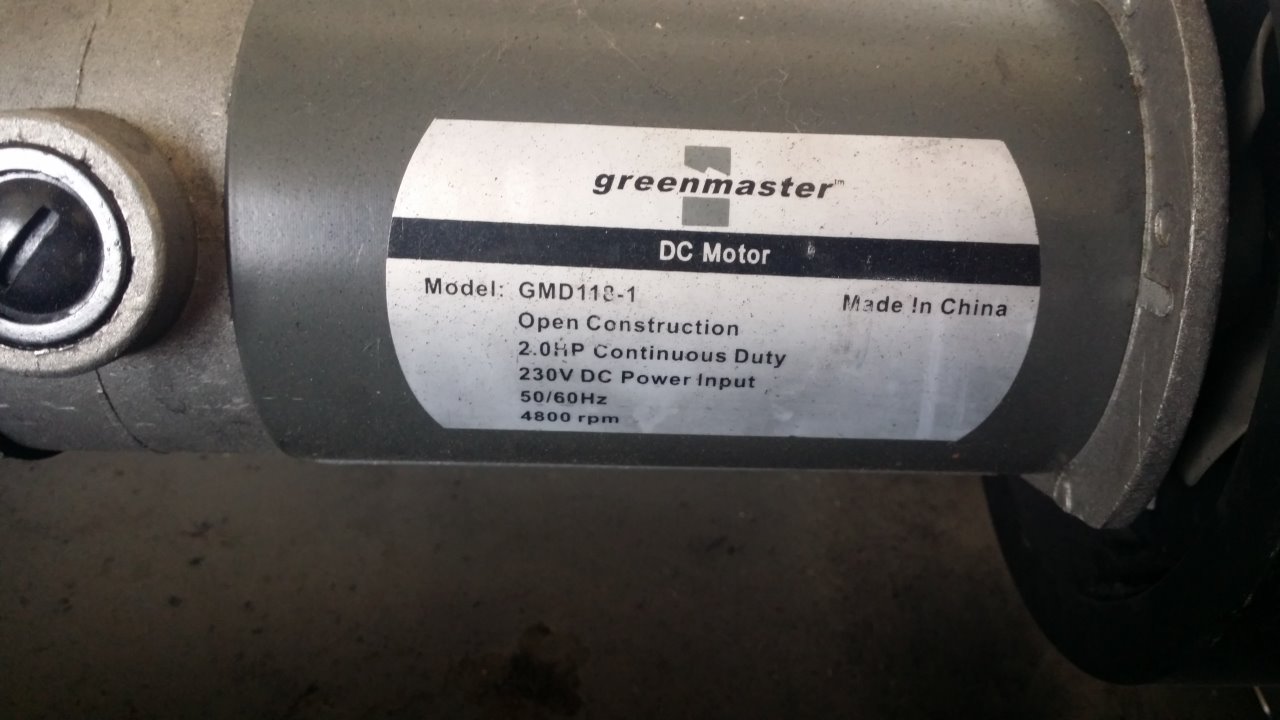
- Main Motor Belt
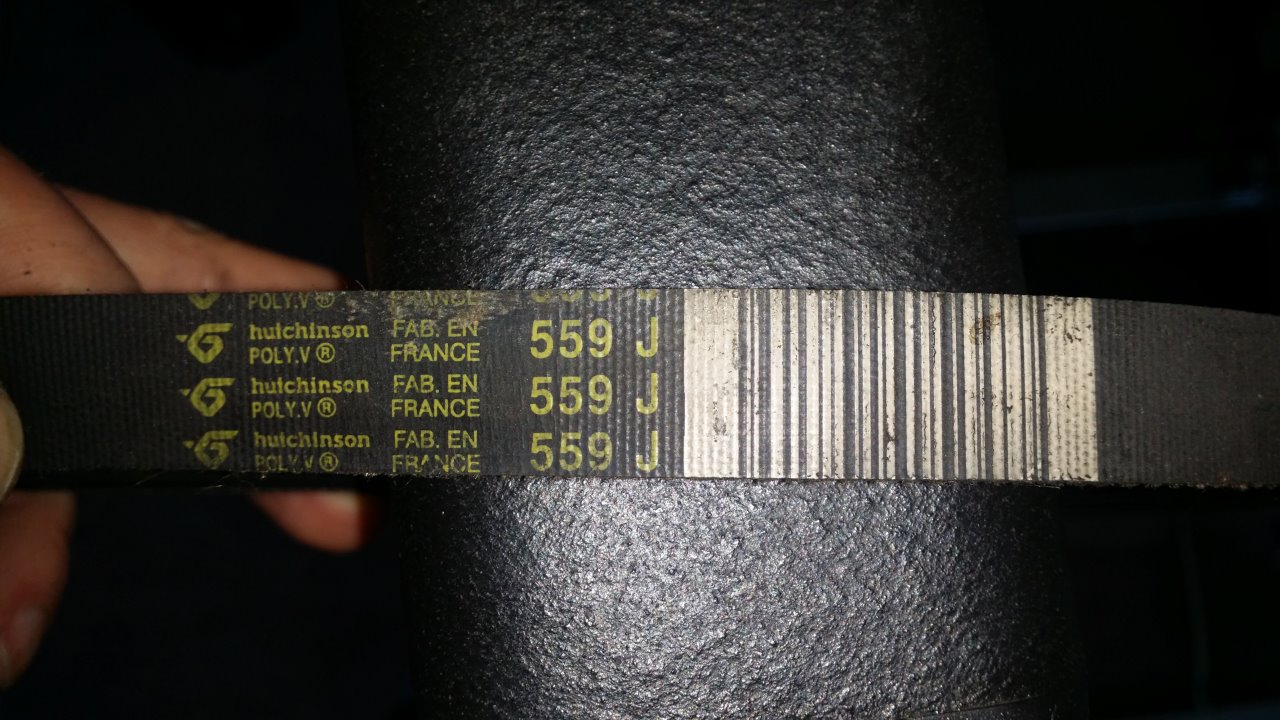
- Power Supply
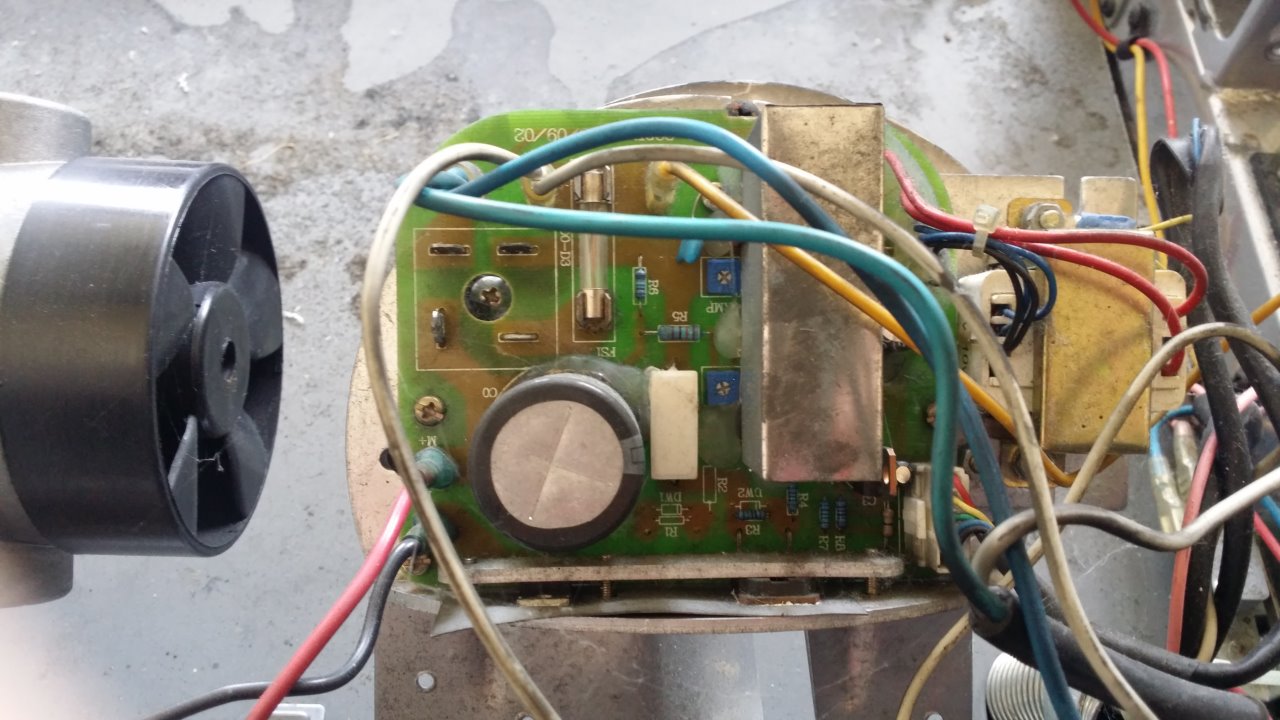
- Power Supply Switches
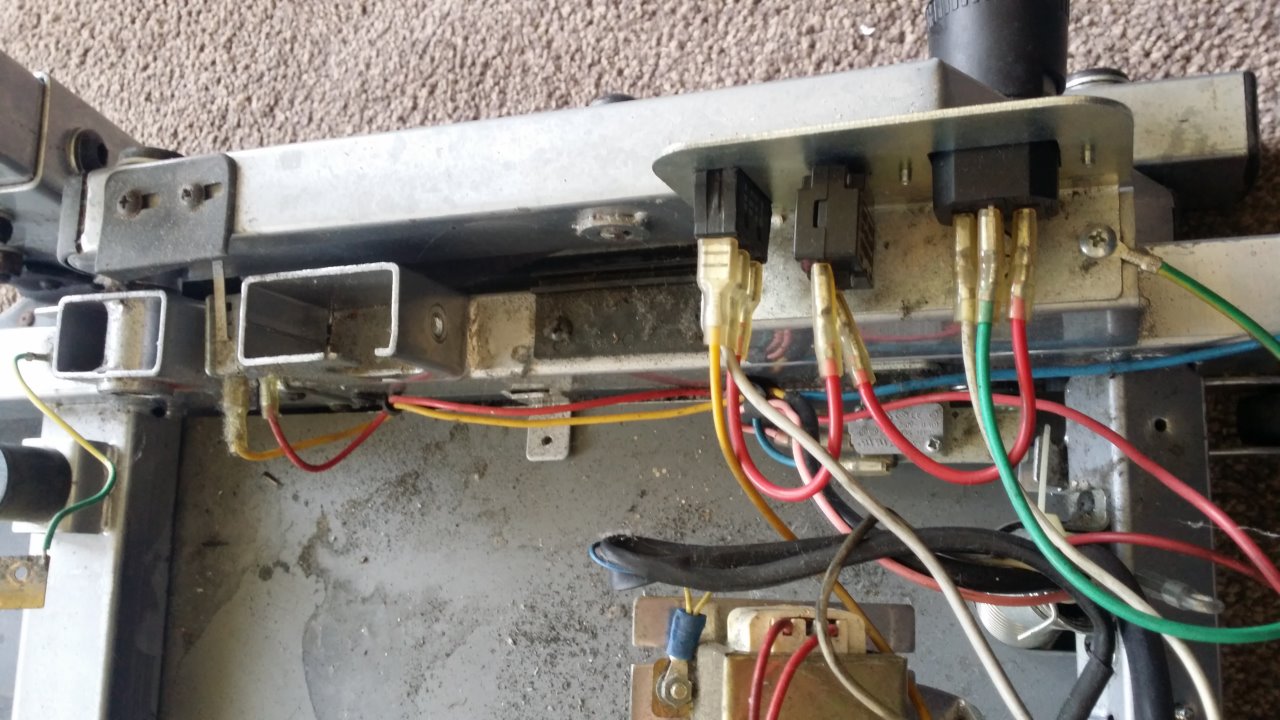
- as
